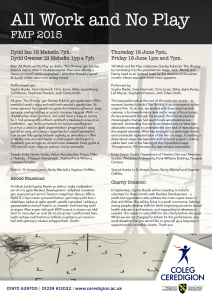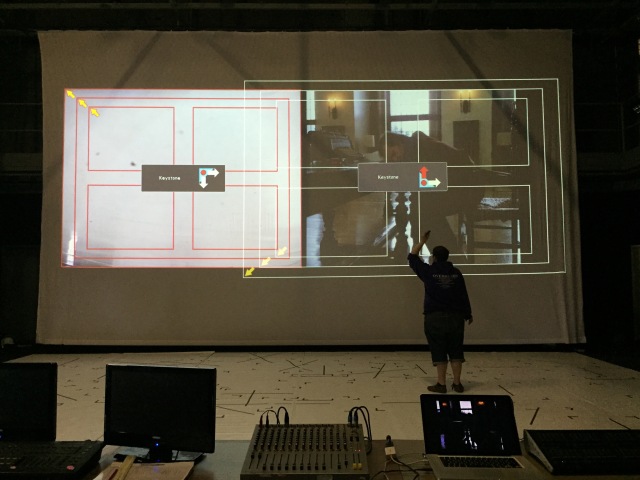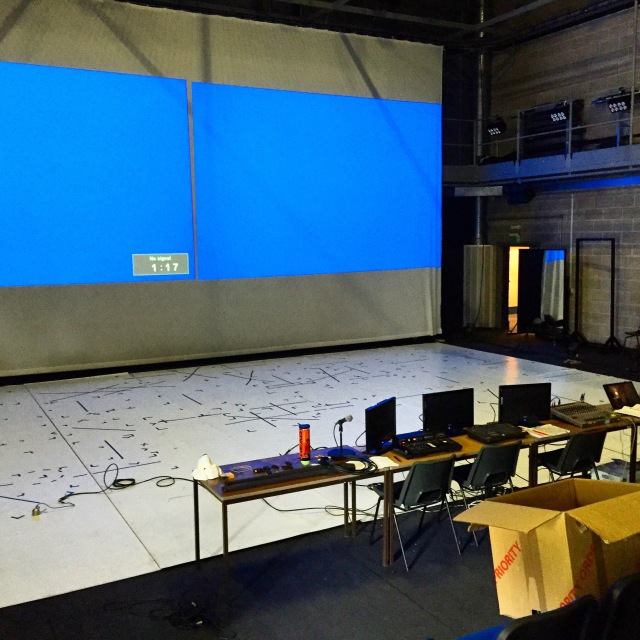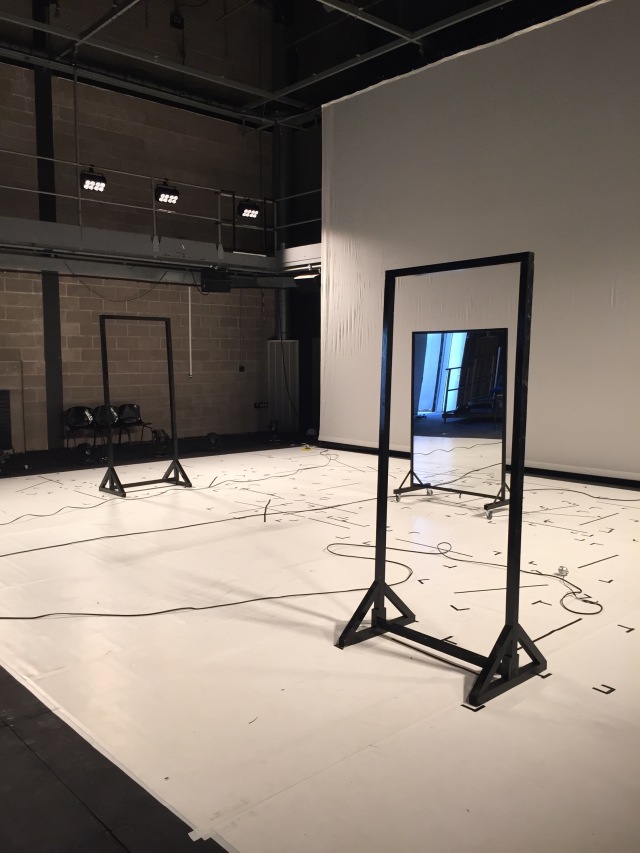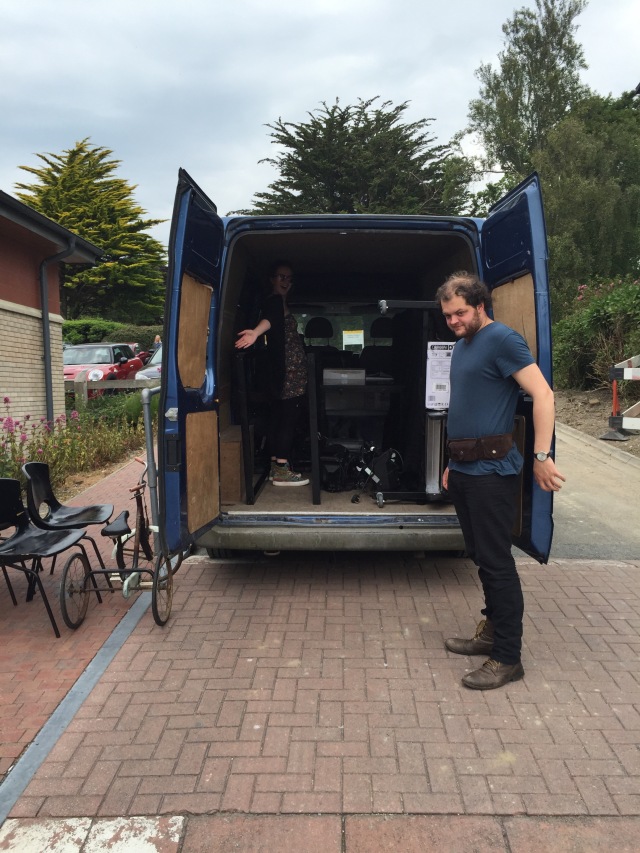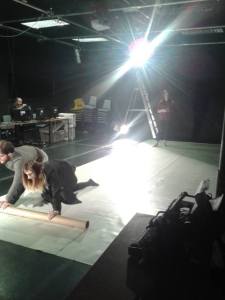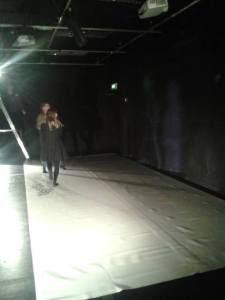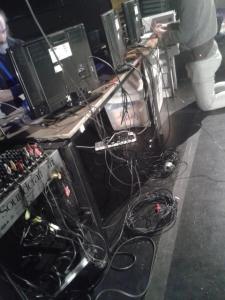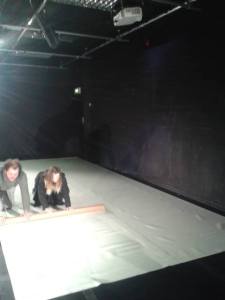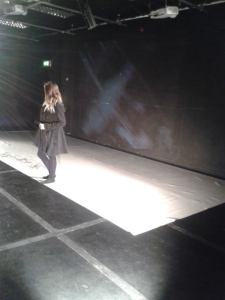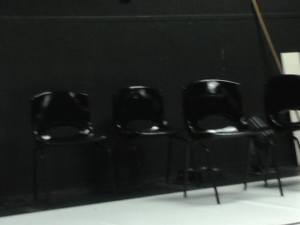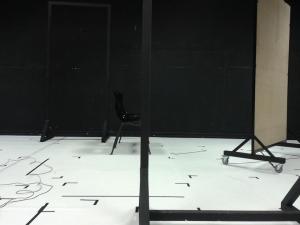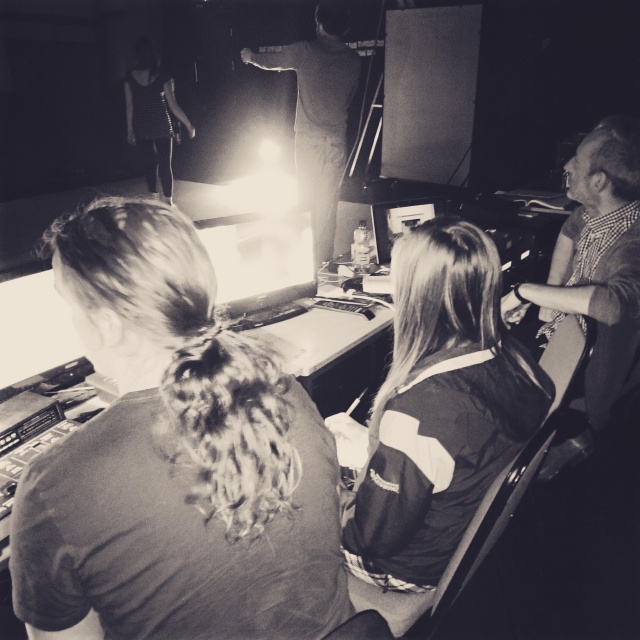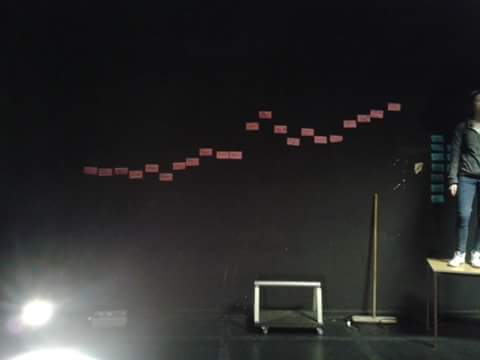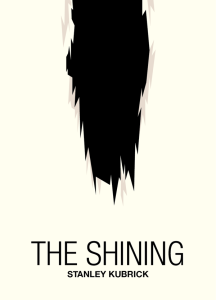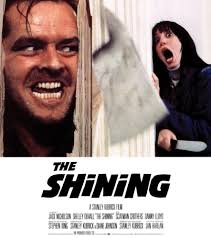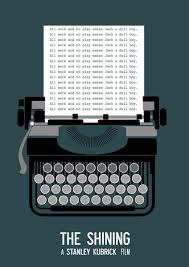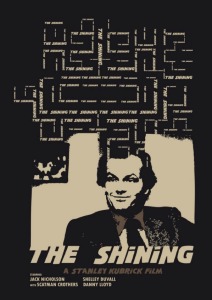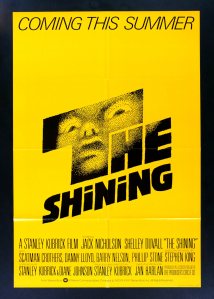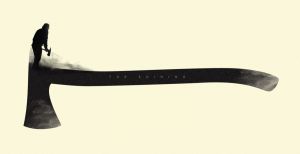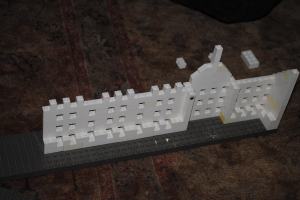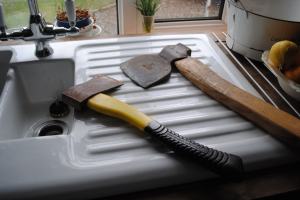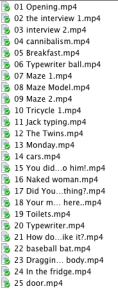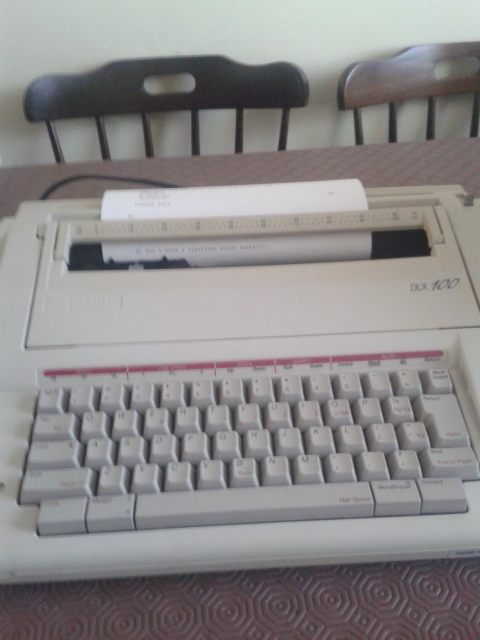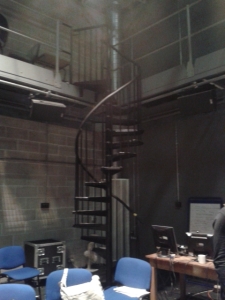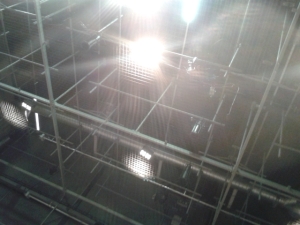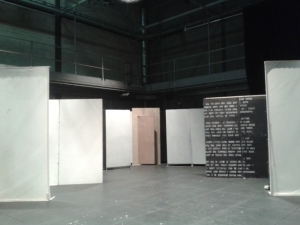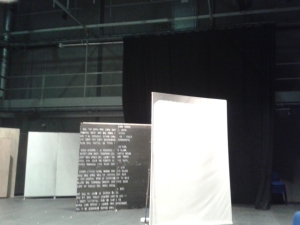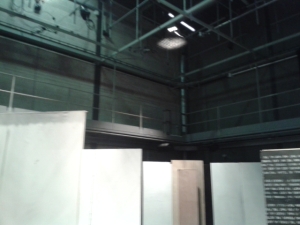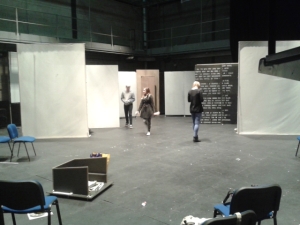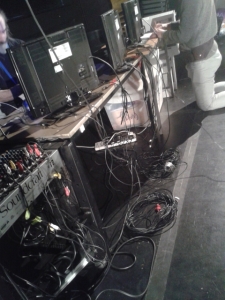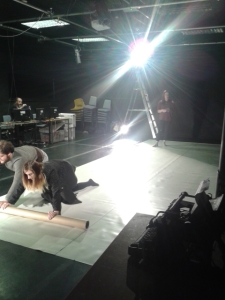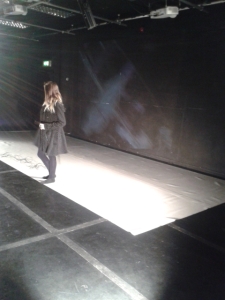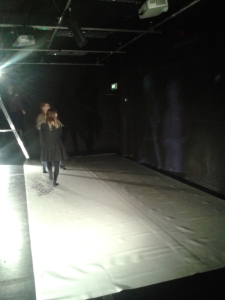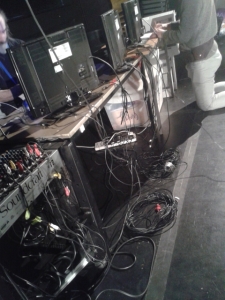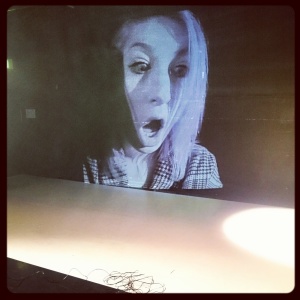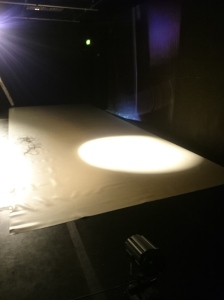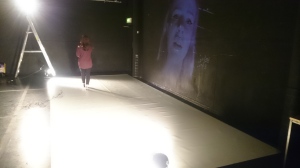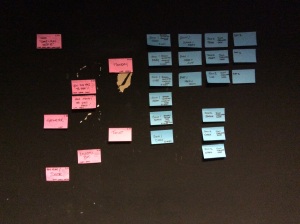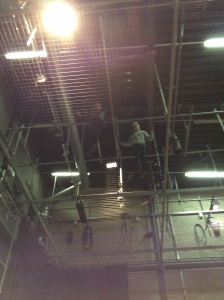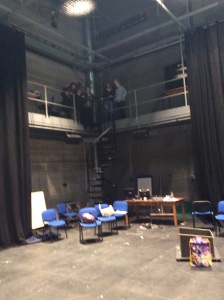LIEF EVE MACIAS- response to questions.
Final Major Project- Log- On performance and process.
From the first day of our final major project rehearsals, we managed to fulfil every rehearsal with learning text, actions and gestures and camera work. The rehearsals were never easy, a lot of the time they were intense, stressful and were very much in need of patience. I feel like we managed all of these elements with intelligence in finding ways to work around shots, and finding the best ways in making them as close to “The Shining” as possible. I found myself and the group feeling surprised at how compatible we were with the characters from the film. Therefore the hard work was completed very early on, although the stress of having complications, mistakes, technical problems never managed to fade away. Yet this is something we realised that we needed to accept and keep as a part of the performance and the main key point.
We progressed slowly at first, as it was difficult in not having everyone present within the group and rehearsals. Therefore many people lost the clarity and memory in many of their queues, which meant us having to recap over certain elements, Yet when finally knowing everything off by heart such as remembering the ordering of scenes etc., the progress got much faster.
The performance became more professional with our choreography as the crew and camera people; in making sure we place props and walk across the space with reasoning and looking as if we know exactly what we are going to do and when.
I feel like some of our rehearsals became flat, our acting was lacking, emotional connection, projection in our vocals were weak and too quiet, reasoning and meaning behind our actions needed more belief and thought and the professionalism. Perhaps due to the amount of times we had rehearsed the performance, I feel like sometimes people as well as myself, lacked in having energy in what we were doing. Yet when it came to our performance and our nerves and excitement kicked in, I feel like this brought us all together even more as a group, the emotions and feelings became one and we all found that large amount of energy running through our bodies. What our tutor Ash and we as individuals and a group were hoping that all the faults and elements that needed work would suddenly come together and have life to them, the emotions would become real; the vocals would be larger than they ever have been. I think that many of us had doubts about how well the performance would go, whether the feedback from the audience would be good, and whether the type of performance that we were performing, that was very different and unique and not our usual type of style would be successful.
Thankfully the performance had an energy to it from the beginning, as we often had trouble during rehearsals in making sure the first few scenes didn’t drag to much or feel slightly flat, as they were also very important, but because of the energy and pressure we were feeling from having an audience, this made it feel very fluid and had a great tempo and atmosphere to it, which was a relief especially as it was giving the important story and facts to the film and performance that the audience would need to know to understand.
The last sequence of the scene was the best it had ever been, as it looks very chaotic yet the operating and camera shots were very clear, and we were more accurate in what we were doing and where to move within the space. I felt out of breath, tired and had butterflies throughout, which id never really felt before which I felt was a great help in proving to myself that I worked harder than usual with my vocals and physicality.
The response from the audience was amazing, to be able to see people sat on the edge of their seats, to hear laughter in the more dramatic elements of the performance is something I wasn’t expecting as much of, although it was nice as it showed how our they enjoyed our interoperation of the images actions and scenes- e.g.- when Chris is frozen Jack at the end of the performance- this gained much laughter on the evening performance. A lot of the response from the audience was how they felt a mixture of emotions and enjoyed our directions too one another and how there were mistakes and it was as if they were able to see from the backstage point of view. Rather than the perfect completed performance on stage.
Dress rehearsal
Day 2 in venue
Get in
Get in
Loading the van
Jobs to be done which we have all mentioned at some point
TECH JOBS FOR THE THURSDAY SESSIONS WITH AJIJO (Just Add in the comments)
1. Creating the axe head/blade. (Josh or Chris).
2. Re painting the axe once completed. (Chris).
3. Paint the knife. (Steph).
4. Paint a bit more on the bat (Steph).
5. Write a check list for props when moving to other studio. (Sophia).
6. Write lighting check list when moving to the other studio. (Lief).
7. Paint Window frame. (Abby).
8. Black background for the beginning credits. (Steph).
9. The end sign which Abby or lief holds needs to be made. ( anyone who is free).
Notes from morning run through
Get initial mix right to incorporate titlesSteph do it somewhere without black marks
Will need new titles
The interview- Steph on Abby
Energy and commitment and clarity of opening scenes
No steering wheel
Quiet with placement of furniture
Like continually adjusting each other
Careful with cables and furniture moving
Hotel and a month later
Try not to run or jog between scenes
Shots from end of bike to lief typing -22 mins
Vocal levels from the start- drown out the actor in your ear- remember that there will be audio in the space to contend with- gives it the urgency and rawness
Can lief change the quality of her voice as forester when shot goes to hotel 28 mins
Monday
Abby look at shot of lief coming through door behind you and level up
Camera shots on Steph and lief very wobbly
Batteries starting to die
Don’t stop watching the shots you’re producing
Tape camera connections
Transition into tv 45 mins
If wires in way, shift them before placing furniture
Abby- we’re sort your call….
Abby- scene with Sophia- are you sure it was the right room- look at Wendy’s gestures
Sean- good evening fire service….
Sean kdk1…. Know cues
Sharper lief into baseball bat
Tech boxes 1.15
Filming murder in mirror
Does hallo ram also scream when killed
Let yourselves go and find the emotions- rawness
Run- your lives literally depend on it
Keep shouting for those cues- adds to urgency
Elevator 1.36
Sign needs to be made
Lief Eve Macias- Journal Ten
Within our last few rehearsals, we have mainly concentrated on our delivery within individual scenes, by delivering the vocals and actions much louder and larger than how they are said and acted out within the original film. Not only did we concentrate on our precision in getting the certain elements exactly the same as the film, but we added and incorporated our natural senses and reactions within the scenes we were performing in, such as adding more breath and sounds throughout certain e.g. – I had never used heavy breath within “Typewriter” before, although I discovered that I found it much easier to be able to add much more emotion within what I was doing, I felt more within the moment.
This really helped in rehearsing with our headphones once again, as this really helped in bringing much more attention to detail. I think this was because this blocked out our surroundings a lot more, we had much more chance to engage with what was being played within our ears, sometimes the words got lost when being played within the space, as we would often get distracted by something happening within the space. We also discovered that the performance became very interesting without the soundtrack playing loud within the performance space. This was strange as it made it feel and sound completely different to what we were used to hearing, seeing and feeling, especially for the audience. It was really interesting when taking off my headphones and just hearing the performers themselves having to perform to the best of their ability to hold the performance together when having no sound to guide it or set a certain atmosphere and tension for the audience, especially when having scenes that are very dramatic and tense. Although many scenes themselves didn’t have sound or music within the background, we also discovered how the large scenes are able to hold the attention well as they are exciting, large and powerful.
Many rehearsals have lacked in peoples absence and reliability for one another. The rehearsal has been much more difficult especially on days when having been planned on concentrating on run-throughs. Therefore we haven’t been able to get as much work done as we had hoped for, so far I have found most rehearsals working better when not having everyone in, mainly because that consists on having the people who are always in within rehearsals, therefore they run smoothly as everyone is slightly more aware as to what is needed to be done or work and scenes that we have perhaps changed or altered in some manner. Therefore our last rehearsal didn’t go as smoothly as we were expecting, mainly because we could have had a much more professional approach to the whole thing. To the camera work, in being much more sensitive and considerable in how we are placing them, where our shots begin and end in order to display a sharp precise image and action, I found the camera work was really messy and all over the place last rehearsal, and every time I took a moment to look at the screen I found our work to be lazy and lacking concentration and care. This is something we really need to take be aware of for next rehearsal, to be as professional as we possibly can, and as prepared, being more confident in what we are performing more than we have ever felt as a group and individually, in order to reveal and give a professional show, as we have done before, and to remember that we can.
Stephanie Pearson Journal 10
Journal 10
In our rehearsal process I think that we have managed to get where we wanted to get to, as far as planning out what scenes we wanted to do in our performance, based on the original scenes in ‘The Shining’. I feel that we have also managed to accomplish how we were supposed to set these scenes out in the space, in the way of what props and set we needed, and have managed to set out where each prop and set needs to be.
Within the last two weeks of rehearsals we have had several absences, which I find has let us down as a group in the way that it has delayed our progression in clarifying the new scene transitions, in the last 15 minutes of our performance. Also it has hindered our ability to clarify who is handing over or placing certain props or actually moving set into the correct are within the performance space. These absences has also made it more difficult as a group in doing full on run throughs of our performance, and because of this I felt that these people, including myself when I had two days off from being ill, has affected everyone’s memory of what scenes is next. This then makes it harder for everyone to remember what prop or set they are moving as one person who has been in everyday the past week knows what they have been doing, while the absent members have forgotten which means the people who have been in has been moving their props or set for them. Making it harder to see the clarity between scene transitions when there is props and set still in the performance space from the previous scene, which shouldn’t be there for the following scene.
The consequences of people missing rehearsals is the fact that these people then become out of the loop, missing changed in scenes, for example, we have change the positioning of two of our scenes such as ‘Breakfast’ and ‘Toilet’. I could tell in our performance run through this Friday the 15th of May that the people who were absent and are portraying characters in these scenes, had a lack of concentration, due to the changes. I could sense this lack of concentration coming from all seven members in our group, including myself, as we haven’t managed to have the full present group in rehearsals to do a full run through. I believe this is the reason people were not concentrating on the task at hand, which this project is a really big task to begin with, and this then lead people to not put enough effort in their vocal and emotional delivery. It also caused hesitancy when moving set as people weren’t sure if they were moving the right thing or where it goes within the performance space, this then caused messy transitions and lots of members getting in the way of each other.
When it came to the camera work for our scenes in this full run through this Friday I felt that it was very bleak as , yet again, the absences has made people forget the changes we had made the previous week, and the camera changes were bad as well. As the operator for one of these scenes which had gone wrong one member had picked up the wrong camera which made it hard for me to remember what my next que was as in this scene we use all three cameras. This then made me do several mistakes and several more when these members managed to swap the cameras over as I wasn’t sure if they had or not. As a camera operator I think that if you have realized that you have picked up the wrong camera, do not swap it for the camera you were supposed to have half way through the scene as you need to give the technical operator the chance to make changes to the operating, if the cameras are wrong.
On a positive note on the days when only four members had shown up for rehearsals on several occasions we had managed to go over the vocal and emotional delivery of the scenes us four members were a part of, which is good as I felt it gave us more confidence in how we could transfer our notes and techniques in these scenes to the other scenes we might be doing with the absent members. In our group of four we also managed to complete the marking out of set changes for each scene, and wrote down on the black tape in our new white pens what scenes these marks are for to help stop confusion when it came to all the little marks of tape on our white dance floor.
Get me out of here
Pictures of Rehearsals and technical I have so far (6/5/15)
Ground plan
Feedback to Runthrough 1 29 April 2015
1. Initial camera shots of scenery – can we re-figure this to include surveying the space and the spectators.
2. New method of moving the car
3. Josh- study Ulman’s initial gestures
4. Tech through all elevator/blood shots
5. Tech through all titles
6. End of “cannibalism” – need fade into the car
7. Relook at camera shots at beginning of breakfast into mirror – not convinced we’re doing the right thing
8. Chris – study Jack’s actions and gestures throughout breakfast
9. Steph typing (at 26 mins) – missed on screen
10. At 28.10 – sharper move Lief into filming Chris on tricycle
11. Missed doors for “Twins” (Abby and Steph)
12. Have a look at camera op/edit during twins- missing several shots
13. Transition into “Monday”- Lief in place and coming through door – needs to be quicker
14. Abby – constantly adjusting self and playing with hair – distracting throughout.
15. Look at beginning of scene between Jack and Danny on the bed – a lot of the initial camera shots bear no resemblance to the original.
16. Find ways of keeping camera still when you have a sustained shot
17. Transition into Sophia with cars – need to solve getting cameras sorted
18. Crossing over front of space- would prefer if this happened on other side of desks
19. Investigate cables coming down from ceiling.
20. Steph at bar – hand gestures work really well – need to study the direction and angle of his head now.
21. Abby – need to prepare self more emotionally when come in with baseball bat – not working yet
22. Abby performance of Danny – need to bring belief to it.
23. If Sophia can’t use real phone, we shouldn’t have one at start.
24. Filming the kiss needs sorting
25. Should there be a doorway in the corner when Sophia enters?
26. How are we going to do the ‘Redrum’ door?
27. Lief- quicker and more dynamic into smashing up kitchen
28. Abby and Chris – study gestures and actions of Jack and Grady in the toilet – lots of work to do on this.
29. Mirror during toilet scene?
30. Chris and Abby must thoroughly learn toilet scene for it to progress
31. Lief with baseball bat – quicker from “KDK1”
32. Can we make sure paper is always set in typewriter at the beginning of the scene and the box of paper is in place – can be done just before.
33. Danny shots during baseball bat – missed
34. Chris – a fantastic Wendy at the end!
35. Work through all of end sequences prior to the maze to the end.
36. Do we put Halloran’s journeys into Fast Forward?
Joshua Tofani-Smith- FMP Log 9
F.M.P Log 9 What do you need to do to improve your performance? Earlier on in this procedure, there would have been more problems to identify and correct, but at this later stage, almost all is done. The few personal corrections that are left is mainly gestures and direction issues, namely key gestures on certain scenes such as ‘Door I’, ‘Baseball Bat’ and more recently ‘The End’. The ineptitude in the final scenes can be put down to unfamiliarity as these were introduced quite recently. However that does not apply for the former two scenes as they have been part of our scenography for some time now and their components should be a part of my physical vocabulary by now. An effective solution to not only retain the gestures would be to compare them to the sounds that occur within the film so I can remember at what point to perform said gesture. This has worked before to considerable effect, not only with gestures but also in remembering what section of film happens next and preparing for said scene. However for practicality purposes, this is not a viable long-term strategy as while it is effective, it is not necessarily professional and so an alternate method needs to be developed. How do you feel about this performance? As a part of the performance and the work that we have put into it, I feel amazed that we have developed so much in such a short space of time that contains so much necessary detail. I think this is mostly down to the standards that we have been working to in order to develop a good working performance that we can be proud of, such as having to be exact in the details, specifically about the definitive gestures. Mostly, my opinion about the performance is one of pride; however the high standards required do leave their mark in the form of a near obsessive pursuit of perfection. This can have an destabilising effect on a person’s self-confidence but apart from that, I feel that this will be one of my greatest accomplishment. How do you want your audience to feel about this performance? The desired effect that we would prefer to have the audience depart with is very similar of that of the original film. That is to say, the thrill of the ending where we discover that Jack’s spirit has been taken back in time with all the other caretakers to live out a comfortable afterlife in a small sliver of 1921, the anticipation that comes with both the depiction and the audience’s knowledge of Jack’s slow descent into madness. Our main intention is to depict the film so accurately that the audience will be convinced that they are watching the film, along with all the emotions that are involved. What are the key areas that we need to improve upon? As mentioned in the first question, not only the lines and setup need to be improved but also the way that we present it. Such issues are new to our situation or as our progress advances further, the most notable of which being the camera angles and the professionalism with making sure they are finished before you move. Others are more personal, such as remembering who is in charge of what camera for a particular scene. At this point in our progress, this is the most notable cause of delays for us and an definite obstacle to be overcome if any further progress is to be made.
Lief Eve Macias- Journal 9
I need to improve my performance by becoming more involved in the actions and the story behind my performance, perhaps to relate it to real life situations that I have been involved in, to enable a more believable realistic emotion “Have you ever ran away as fast as you can from anything or anyone before” I find it really helpful being told to take a few seconds to think about how I would really react and to image. This is one of my aims throughout the performance, as I found it to make my performance stronger and more powerful and meaningful.
To improve I also need to make sure my actions and facial expressions are within the right timing of the film. I Learnt each and every action within my scenes, yet it’s the matter of getting them in the exact same place as the character I’m playing does, as I discovered last rehearsal that my actions were slightly out of place, therefore I need to take extra time to rehearse and watch over the film many times in order to remember and gain queues that I could perhaps learn in order to get my actions, and sounds within the correct places.
Performing this type of work, makes me feel a mixture of different great things, such as feeling like a strong independent woman who is able to take orders and give orders to the rest of the group, to be able to talk and understand one another in a certain communication work level, with a professional approach and attitude. It almost makes me feel like we have our own language, and only we as camera people, operators and actors can understand at that moment in time, in order to get everything perfect and within time. I feel certain exhaustion as we have to work mentally in constantly changing characters and roles, yet I feel an excitement that rushes through my body at times when knowing and feeling when something is exact to the film, or when witnessing other members of the group performing amazingly and being able to compare to the film, or even at times when there are mistakes, I feel like this is exciting in being able to see how we deal with that as a group and work together in order to succeed in solving the problem, as at times the mistakes are often the elements that stand out and turn out to be exciting beautiful chaos. The constant movement, sounds, shadows and props within the space, they create a certain atmosphere that keeps people on the edge of their seat and they are constantly witnessing new things and nothing is ever expected.
I want my spectators to leave with knowing that they have gained an understanding appreciation for our hard work in recreating “The Shining” and being able to see that it really is “All work no play. To enjoy comparing and finding similarities between us performers and the actors within the film, and traveling and joining us within the journey of the recreation, the journey of our individual characters and the many different emotions throughout.
In the next few weeks, we need to focus on line learning, as we will be having run throughs of the performance, whilst taking out the speech from the soundtracks, and will only be working with our own individual voices. Therefore we need to make sure we project our voices much louder, as we are used to the original voices over powering our own voices. We also need to work on the choreography for the doors and the windows and other props, in a smooth effective way, that is quick and sharp as we are wanting to place them only when needed, e.g.- for only when walking through. The last few rehearsals, we managed to finally being to feel and believe and be involved in what we were doing, I think this was because we are beginning to remember the ordering of everything; therefore we are able to concentrate more on our performances. We then need to concentrate on building and creating all of our props that will be needed in order to be able to work with them all fully, in order to work out where in the space they will be needed and when.
Stephanie Pearson Journal 9
Journal 9
I feel that to improve my own performance is to look carefully at the film and to look at the gestures and facial expressions they use, so that I can attempt to develop each of my characters, so that when I change from one to the next I know what mental and emotional state I have to prepare myself with once I get into character. I will also have to look at the original film to see how each character talks so that I can get a similar pitch, and to get the accent and other unique ways they talk, so that our version is as close to the original as we can, to give a better sound quality over the background soundtracks which is what the audience will hear. To improve the clarity of my performance I feel that I will have to write down all of my ques on what jobs I am doing for each scene or in between scenes when it comes to moving props, moving set, camera operator, technical operator or becoming a character.
Performing this work I feel makes me feel quite venerable when I am acting as I have to switch between characters quickly making me feel pressured in bringing out different emotions all the time instead of having to stick to one character. This means that their emotional state I have to portray is the same while I have to let it develop, but in this work I am portraying four different characters, and they all have different emotions and quirks. Meaning I have to quickly change my mood and that’s vulnerable as it doesn’t give me time to adjust. I also fell that performing this work is exhausting down to the switching of characters, and also rushing around the space in getting to your next que on time, to having to concentrate so hard on all of the different things going on that the mental struggle helps make me more exhausted too.
I would like the spectators to come away with a sense of appreciation for us performers as I want them to be able to see how much work we have done in our rehearsals leading up the performances, by seeing the bear minimal props and set we have used, and the fact that we wanted to make our performance vulnerable by showing everything and having all the cameras and technical desk in the open where the audience can see everything.
In the next few weeks I believe that in rehearsals we will have to figure out what parts of the beginning of the film which we should keep or take out as we want our performance to be upbeat while still keeping the important information needed. We will also have to be really critical in our clarification of the door choreography for each scene, mark out where set goes onto the dance floor with tape, and also bring in all of our costumes, props and set so that we can get as much clarity between scene changes, or scenes themselves.
Sophia – Journal 6&7
We have experimented using wireless headphones which play the film all from one devise so we can all hear the same thing. We rehearsed a few scenes with the headphones and it worked really well, because we are trying to hear ourselves over the headphones is causes us to speak louder so the original film doesn’t drown out our voice. I think we are going to use these in the performance so we can get our cues perfect and it’s also a great prompt if we completely go blank with what comes next. I also really love the way it looks in the space because it takes the naturalism away from what we’re doing and it seems like it will disconnect the audience from being completely taken away with our action which is very Brechtian.
We have now started to work with the film instead of separate clips so we can get more of a sense of what it will feel like to perform and actually how little time we have in-between scenes to get prepared for the next scene. In a way I am finding it easier because we don’t have to have a discussion about what needs to be where because we have no time for it so we just have to get on and do. It also visually looks really interesting because of how chaotic it has suddenly become with the scene changes having to be quick and sharp and suddenly going from an actor to an operator. In other ways I am finding it more difficult because I don’t feel confident with the order of scenes yet so I am unsure of what props to set up and get ready for the next scene, but I think this is one of them things that will come with time. I think working like this from now on will really speed our process up because we are just being completely thrown into to scene after scene after scene which means our concentration levels will have to be a lot higher and in a way it forces them to be because it wouldn’t work otherwise.
We have been working with the first 15 minutes of the performance which I’m actually finding more difficult than all of the larger scale scenes we have already worked with. I think I’m finding it difficult because it’s fairly slow and in some ways quite boring, so trying to perform it in the space and make the long convocations seem interesting is actually really difficult. I think it’s easier to be small in a film or on television because you can speak quieter and and have small subtle movements, whereas when its theatre you have to keep the audiences attention and they need to hear you so speaking quietly is difficult.
I think we are going to have the actual film playing in various areas around the space and on the row of tables we use for operating. We have discussed having three laptops on our row of tables so the audience can refer back to the film to see if we are copying the characters correctly. I think this will be really effective as long as we are exact, when I have been operating and watching scenes side by side to the actual film and the movements and lip syncing is perfect it looks absolutely fantastic so it would be great for the audience to experience that too. The reason we will only be having them on small TV’s and laptops is that if we had a larger projection of the film I think there would be a massive danger of the audience just watching the film and not what we are doing, especially if the lip syncing is perfect because it’s really interesting to watch the film whilst hearing our voices. I think having the film there for our use as well will be really helpful so we can refer back to the film to see if we are getting certain moments correct. I don’t think it will ruin our performance if we occasionally look at the film ourselves because it just reminds the audience that we are still just performers in the space.
I feel like we have all improved with our scenes and characters, especially with the emotional content of the piece. We are all becoming a lot more confident in our roles in certain scenes and we are beginning to see the performance as a story instead of separate scenes which is making it easier to connect on a deeper level to our action and portrayal of the characters.
I think the main thing we all need to improve on and take more care with are the camera angles in shots. I’ve noticed that because some people think they know what they are doing they do not refer back to the film to make sure the shot is completely spot on, and I think us as camera operators can afford to look at the original film as much as we like to get the shot lined up perfectly. In some cases it is still just because we are not completely confident in our next shots so we tend to forget that we have to change the angles at different times. I think we also need to be in shot ready for one camera to cut to the next because otherwise we are still getting in shot whilst the the camera is up on the projector.
Sophia – Journal 9
I think I need to improve my personal performance by remembering my lines and cues. There are two scenes in which I have a lot of speech and I don’t know them as well as the others so I struggle with remembering and can’t go all out on the action because I’m thinking to much. Also we have recently added a few short scenes with Holoran and Jack and I forget where they come in so am not ready on cue to perform. I think it will be the sort of thing that comes with time and rehearsals though. If I’m not completely in performance mode I find I occasionally zone out and daydream for even 10 seconds and then that’s it because I miss cues and little things I forget about completely catches me off guard. I think I need to stay focused as soon as the play button is pressed and stay that way.
Since we have got further into the process I’m feeling more of an emotional connection to my action and text, because I am so confident with my lines in certain scenes I can completely let myself go when I am performing because I’m not desperately trying to remember what comes next. In a few scenes I still am struggling to find an emotional connection though. For example in the beginning of ‘Did you find anything’ I am still struggling to perform it with conviction because its a fairly quiet scene at the beginning and obviously Jack has a deeper voice than I have it puts me off because I can’t get my tone of voice like his at all, whereas in some scenes when I’m playing Wendy and I can get her exact tone which makes me feel like I’ve succeeded in portraying her. Performing this really emotionally and physically drains me because there are so many different technical roles and different emotions of the characters, which we have to step in and out of so it’s like being on an emotional roller-coaster. I find it more difficult than our healthy performer lessons and that was pretty intense.
I think I really want the spectators to be impressed with the detail we have to learn in this, I really want them to appreciate what we had to put into the performance to make it what it is. I also want them to be taken away by the story and come out like they have been in the cinema watching a film with a ‘wow’ factor. Although at this point I still am a but unsure about what I want them to come away with and it will probably change again in the next few weeks of rehearsals.
I think one of the key areas we really need to focus on over the next few weeks are the camera shots, I’ve noticed that recently some people aren’t getting the right shots and they need to be tweaked to get it right. I think it’s really important that all of the angles are right and we are ready in shot for when we need to be so it’s smoother. The other key areas are defiantly the small details in characters movement which is the difference to a generalised performance of it and generally knowing what we are doing and when. I think some of the best scenes are when we have got every little tilt of the head and hand gesture in side by side with the film perfectly. For example ‘Bar 1’ always makes me smile because of how accurate Stephanie is with her movement and voice.
Joshua Tofani-Smith- FMP Log 8
F.M.P Log 8
The rehearsal that was commenced today was an adequate run-through of the entire piece, courtesy of the segmented film that was pieced together from the clips that we have been learning the performance from. As a result of this conjoining, the learning curve for the performance has increased with only minor errors to be picked up upon such as the route that the props are taken around the set, in this case directly through the scene that was progressing at the moment when they could have gone around the side where they would not have been picked up on the camera. Add to this the fact that our onscreen preparations are not as fast as they could be in readying for future scenes and they are minor snags in an otherwise passable performance progress. A possible solution to this could be to prepare more beforehand by reading the script and several other ready sources of information such as the post-it notes that have been developed throughout the entire process, in order to be able to anticipate effectively which scene occurs next and prepare for it.
An assignment that would be used only on the day of the performance, is a speech from everybody that gives a detailed account of the background details of the performance that the audience are about to watch. Apparently this will be done before the performance has started which I find the reasoning behind to be rather nonsensical as this would clearly benefit the post-performance audience more than just giving away valuable plot details.
Pre-Performance Speech
‘What you’ve just seen is the end result of just six months work, six months, believe it or not. But it hasn’t been an easy six months to make just an hour and a half. We’ve watched the film more often than you could care to, banging our heads on every single angle and shot just to find out how it works. Then we write what we find in our books and the whole thing starts all over again.
But seriously, there’s been a lot of hard work, a lot of sweat and tears that have gone into this project. For the first two months, the only thing we had to go on was the film and what we could develop by day. But from those humble beginnings of self-developed work, came a framework of around half an hour of our version of the film. This, on reflection, wasn’t really enough.
So we had a look at what we felt was missing and found that there was a large amount of background detail that made the film’s atmospheric background such as the use of images for what they represented. I’m sure most of you will have noticed the ‘Calumet’ tins in certain scenes, the ones with the cartoon Indian on them. What the eagle-eyed of you might have picked up on is that the Overlook Hotel, in the film, is built upon an Indian burial ground and connected it with the design of these tins. This however, is small fry compared to the overriding design in the film’s background.
Many of us found that the basis of the film, while borrowing heavily from the book of the same name, also shares similarities with a far older story that many of you know as ‘Jason and the Labyrinth’. Once you get past the coincidences, a lot of incidences make sense. A sprawling maze that contains a ferocious ‘guardian’- a caretaker of sorts, a brave soul that must escape or lose his life in the process…. Sound familiar?’
Christopher.Jones – log -20/4/15
We have begun to go through each scene without any pauses, this means the transitions in between has been worked through so that it looks clean and that we can make the change as quick as possible. To do the transitions we have given each other specific roles depending on what our positions and roles are in the scene, from what we have so far I believe it’s working very well. I feel like we are beginning to concentrate on the clarity of the scenes this includes the facial expressions and how the words and spoken, I feel like this is the only way we will be able to make the performance better.
As I am in charge of audio for the performance I have been looking at computer softwares which will allow me to remove words from the scenes in the movie, so far I have not found a suitable software as the ones I have tried have not been very clarified, so this means we may have to use the audio in which the words are heard slightly. We are beggining to realise what is needed in order for our performance to be the best it possibly can.
For the next rehearsal I will be looking at specific scenes of mine for example (The Breakfast scene) and really looking at the way my character moves and speaks which shold not take too long, I feel like as a group we should be really concentrating on clarity if done so this performance will have so much more potential.
Lief Eve Macias- Journal 8- Monologue
This performance contains plenty of bad language, gestures and actions from Jack Nicolson’s portrayal of Jack Torrance, Sissy Spacek’s Wendy and Danny Lloyd as Danny Torrance and other characters, our three main characters from the horror film “The Shining”, directed by “Stanley Kubrick” from a book by “Steven King”. Not only will you be witnessing the film, but you’ll be watching it live, performed by us performers who will be recreating the whole film. You may or may not come across and witness stress, arguments, complications and confusions with technical elements and props, but we really hope and can insure you that beside the true realistic hard work and concentration, this involves a professional approach, accuracy, and true connection of emotion; we aren’t just performers in space acting, as we are the subjects. We had to and have to believe in what we are doing and saying. It took time to be able to relate and connect with the acting, as there are so many character changes, also through having to change roles of gender; this was really interesting as it was sometimes confusing. I found myself having to remember that Jack Nicolson doesn’t have a high pitched voice, but a manly low voice, this was something I had to work on, and I think this is where many of us struggled in being able to portray our characters fully.
There’s a wonderful contrast of beautiful and gruesome, chaos and calming moods and movements, stillness and constant moving within the space. The key thing to remember during this whole performance, is no matter what is happening within the space, the action projected on the screen is what is important, the accurate shots and the simplicity of our set that matches the large difficult set within the film, yet we produce the same atmosphere, scenery and action.
The setting plays its part in creating an unsettling ambience, a tense surreal atmosphere,that keeps you on the edge of your seat.
Sophia Journal 8 – monologue
For our final major project we are rein acting the whole of The Shining by Stanley Kubrick. It basically says it all with that because we are literally copying everything they do, every hand gesture to every turn in the head. We’re trying to go into as much detail as how many steps they take and in a few times I attempted it with how many times they blink but it just gets so confusing especially when your concentrating on getting everything else right. We are using three cameras which are projected on to the back wall, and in the Emily Davies studio we are performing in the back wall is huge so it will be like sitting in a cinema watching a film but the film is being performed in the space in front of you as well as the projection of the film with all of the camera cuts. We are operating the camera cuts ourselves using a mixer which makes performing quite difficult when you have to run in and out of being the operator. I really love how the shots are turning out on the projector because of our low budget it looks quite rough and in a way un-professional but I enjoy the raw interpretation of what we are creating, it counterbalances the immense detail in the text and movement because the camera work and operating isn’t as smooth. What ever is going on in the space is completely different to what is being projected on the back wall, it doesn’t matter about the general lay out of the space as long as the projection is exact. So it could be two people having a convocation and facing different ways to each other in the space but on the projection it seems as if they are sat in the same space talking to each other (writing that has just given me some cool visions of us actually doing something like that – opinions?). We are also changing our character roles throughout the piece which is very challenging because each characters emotions are very different from each others in the piece and snapping from one character and what is going on with them to another in one scene change is quite difficult, but I think I’m getting used to the quite drastic change in emotions the further we’ve gone down the process. We will be using different items of clothing to symbolise each different character so it should be fairly simple for the audience to catch on to what we are doing.
Stephanie Pearson Journal 8 (Monologue).
Our performance was tricky to put together as it had loads of different technical aspects such as, figuring out how to connect the three cameras to the mixer desks and how to put these cameras images onto three different TVs, one for each camera. We also had to figure out the best idea in how to be able to listen to the original film, without it being in the present space. As a group or into small groups we have had to figure out how we will manage to move around the smaller performance space, while still giving the same original sense of how the original was filmed on the big projection screen. This was difficult as we then had to change camera angles, which are hard to remember the exact detailed area we as performers are supposed to be as we have many different camera shots, and most of the camera shots are snappy and quick, making it harder for us to move into the next positions we need to be in. Our transitions are a different part altogether, which makes things even more confusing as we have to think ahead to what the next scenes is and what job do I have to do, and during the rehearsal process it was quite a challenge in figuring out who should be what character, who should be camera operators, who should be the technical operator and then which people need to be setting up what props and where, and all of this needs to happen without being seen on the cameras which are being projected on the big screen.
F.M.P Log 7- Joshua Tofani-Smith
F.M.P Log 7
In the most recent progressions, the understanding has been pioneered within the finer details such as the small, unconscious movements generated by the characters during the scenes, most notably Bill Ullman during the ‘Office’ scenes and Jack within ‘Stairs’, those movements that are as much a part of the scene as the lines spoken within them. As a result of our pursuit to ultimately obtain a spot-for-spot rendition of the film, this would appear to be the best course of action to achieve an seamless reproduction, although long, repetitive and no doubt, a struggle to get right, but in the long run, this will benefit us enormously.
The other aspect that concerns me is the rate of professionalism in amongst this production with both actors and designers. Although the adopted work ethic mentioned above will go some way towards negating this attitude, I still can’t seem to declare myself satisfied with the progress made so far. Taking a step back however, perhaps it is the lack of working in the actual stage space, the ‘forced development’ that betrays us and not each other. Certainly the others do not seem to share this viewpoint and are even enjoying the delayed developmental experience, as it seems to give them further scope for improvement.
The methodology that we are applying to the process bears similarities to the theory of ‘Mechanization of Art’ whereby existing art (literal art, novels, performances and films) is made into a more compressed form i.e. digital media such as film, online reviews and video clips. Our methods of recreating our selected film, scene by scene, with the aid of wired cameras fulfils this theorem by means of making it available to a wider range of people and also more appealing to a broader perspective by changing the medium that it is shown in.
The downside to this memorising of the arts in today’s digital media is that they often lose that vital presence imbued within them that so often makes their digital recording worthwhile. To avoid this occurring within our performance, our recreations are done by actual space reconstructions in order to preserve as much of the original vitality as possible. This is slightly compromised by the use of the wired cameras as a drain of this vitality but I feel that the reasoning behind their use justifies the minor flaw generated by this topic.
Rehearsal
F.M.P Log 6
FMP Journal- 17/18/20th March
Our progress so far has shown how that the methods that are being used affect the reception by the potential audience and change their perception of the display. One device that we are considering using to this purpose is by changing set designs on the go, by configuring the set as the scenes are occurring on stage. This, while normally considered sheer chaos, if not unprofessional, has the advantage of opening up the show to the audience and giving them something to understand, if not the whole of it. However care must be taken with this device, otherwise the performance will have a very ‘unprofessional’ look to it, be it unintentional or otherwise.
To minimise the risks of this, these alterations are rehearsed alongside the performance itself, putting particular emphasis upon the placement of the important points of each scene, such as the mirror in ‘Breakfast’, ‘Door’ and ‘Tuesday’ which opens up a different perspective upon each of these scenes and not just in the obvious way, the bar in ‘Bar 1’ and ‘Your Money’s No Good Here’ where it provides a tangible and metaphysical barrier between Jack and Lloyd that references not only the physical separation but also the barrier between life and undeath that for some reason, is especially thin at the hotel.
Another recent development in our performance is that the scene clips that we have been using to learn the intricacies of each section has now been compiled from several short trailers into one long, compiled film that now means that the transitions are smoother and less complicated, particularly now that the change-over time from one clip to another is eliminated from the equation altogether.
Stephanie Pearson Journal 7
Journal Entry 7
In our rehearsals we have managed to add more scenes which are only short in length but helps piece together the longer more substantial scenes which helps make the understanding of the context of the performance more apparent. On top of these new scenes we have managed to find out who will be doing the camera work, acting and operation for the next scenes based on the previous, as we are aiming to get quick clear transition like what the original film was like.
On top of creating the new scenes we have also managed to be able to have gotten wireless headphones which we are able to ware so that we are able to hear the original while the spectators can only hear the background soundtracks and our live voices within the space. As a spectator looking at one of these scenes I found that being able to only hear the live voices and the soundtracks competing against each other interesting as it’s a nice contrast in having two different ways of being able to hear sound in a live space, and how the live vocals are really connected and create tension when overlapped with the soundtracks.
I feel that the progress of clarity in the vocal deliveries and physical gestures are improved in the first several scenes we did as we have had more time to keep on going over these scenes and be able to get more of a feeling of the different characters we are playing, making some physical gestures and tone of our voices seem and feel more real and centred than forced.
As a group we have also discussed whether we should keep the original film in the space or not, and have talked about if we should have it projected either on the back wall of the space, like what we have been doing in college, or have three laptops on the technical operations desk so that the audience can referee back to the original, comparing what us as actors are projecting on the big screen. This then creates different perspectives for each audience as they can choose on what areas or how they decide to watch the performance, by either looking at everything or just the original, which we don’t really want, or at us in the live space and seeing the difference in what is happening there compares to what is being projected on the big screen.
LIEF EVE MACIAS- ENTRY SIX- AND IDEAS FOR INTRODUCTION(PHYSICAL WORK)
This week’s rehearsal was very different, in the way that we no longer worked with the film in sections but we worked with the whole film playing. Meaning that our transitions in between scenes had to be much faster in order to get to the positions needed, I surprisingly found this to be a lot easier than I was expecting, mainly because when having more time this means more time to think about which scene is next or to perhaps be a bit more laid back in where we need to be or finding our cameras and props, also giving us more time to talk to one another and discuss what is happening next, where as when we only have a few seconds in between the scenes we have to be fully focused and prepared and if something or someone isn’t correct we have to be quick enough to shout out and tell everyone, as there is no time to argue or discuss when something going wrong. I think some people found it difficult not being able to pause the film to have a few seconds longer to search for certain elements, but this is something that we all need to be strong and have faith within as we have all learnt that it is possibly to achieve.
Through having a run through of the scenes with the film, this gave us a true real feeling of how the show would run, what it would look and feel like, working at such a fast pace and the hard concentration that is needed. As a group we worked together in making the transitions quick and sharp, through getting the set on stage before they are needed in shot even when another scene is within process and action. This worked out well as it introduced layers, and other interesting exciting elements visually to look at as a whole, rather than just focussing on one thing. As an audience member and performer, it feels exciting the way everything is calm and then suddenly everything will change within seconds and become chaos, sometimes more chaotic than other times. Yet this creates strong choreography in the way that our choreography is sometimes solo, when working with cameras or walking or running to our places, or sometimes it’s working as a pair or team to move certain elements such as tables, mirrors or chairs. The moving together as one to end up at the same place at the same time, having to dodge one another and be aware of our surroundings and if a scene is going on, we have to make sure we are always out of shot, therefore we do movements by the side of the camera, or perhaps diving or rolling underneath it. This is exciting as the audience members are able to see and hear what we are doing yet it never interferes with us creating the film on the projector and with what is in action.
Therefore this is the reason that we have decided to no longer use the physical movements that were created beforehand. Mainly because the whole performance is physical, many people may not look at it in that way, because it’s such a different way of working physically. Although it could actually be much more physical than if we were to do physical movements such as dance or pair work with the use of gestures etc. As a group we decided that there would be no room for it, and it would definitely be a distraction to the creating the film and the other elements going on stage. There wouldn’t be any time to take notice to detail in the physical especially if it was perhaps to be performed on the side at different times. If we were to use our physical I think it should either be at the beginning of the show perhaps as an introduction before we go into camera work, acting or operating. As it could add a twist on the performance, as many audience members would be expecting a certain kind of performance as this has not been done in many years, therefore it would add a surprise which could be even more exciting. Even if it’s us standing in a line or around the space doing certain gestures or preparing ourselves for what is to come.
Perhaps if the whole set was on stage and as a group or as pairs, we found a way in moving it off stage whilst doing physical movements around it or on it, with the operators giving us directions in when needing to start the show. Each light could turn off each prop when being moved off stage, then the lights could slowly come up as we are all standing with our backs turned showing our title of the show “All work no play” with some people standing with their backs turned and the ones facing the audience could be doing gestured based movements, as one by one we run or walk to our positions yet the action of the car had already began and is being projected on the screen.
Or to use us as performers within props as an introduction e.g.- having us all move to certain elements within the space to look and prepare ourselves within the mirrors doing different movements and gestures within the mirror as someone moves it around the space, one mirror moving behind and one mirror moving in front as they pass by one another that’s when we all come together as a group and split into moving the set by perhaps sliding across the tables etc.
Props facing the audience-To use props such as the doors, having us walk through the doors one after another, looking as if we are walking into a room, with the ticket that says “Room no 237” suddenly the set moves apart and lights slowly come up as we transition to our places.
Posted note pictures
Second visit to Emily Davies studio

Stephanie Pearson Journal Entry 6
Journal Entry 6
This week in our FMP rehearsals we have managed to add several new scenes which are at the beginning of the sequences. We have managed to completely block these new scenes out with the camera work, but they have to be improved as some of the camera shots are really quick so the camera people need to be really focused to get the video clarity. Transitions also need improving and we are starting to work out the permanent positioning of set in the space so that we can start working out the areas these set needs to be put off stage. We have managed to get a wireless radio signalled headphone system which we have managed to use successfully within some of our scenes, and have found out that they work extremely well as we, as performers, can hear the original sound and voices from the film ‘The Shining’ while the only sound the audience will be able to hear is the soundtrack to these scenes and, and our voices live in the space. The other thing which has changed is that we want the audience to see the original film as well as our DIY version of ‘The Shining’. So we had the idea that we could have three laptops or screens on the long technical operating table facing the audience, so that they can reference what we are doing within the live space to what is happening in the original film, creating a different aesthetic layer, and to overwhelm the audience in a good yet strong way. As a group we have had to change some of our scenes as in who will be operating or who will be working with a camera as Chris has missed two FMP sessions. This meant that we weren’t able to cast him as an actor, camera operator or technical operator, so this made it more difficult for the rest of us to work on the new scenes quickly as some of the camera shots were hard to do as we have a small group and most of our group needed to be actors. This then made it difficult in transitions to the next camera shot as we will have to change the person who the camera will be moved to, making the camera shots not clear and, the clarity of the video shaky and not straight.
After this week of rehearsals I think that the performance is going good as we almost have all of the body made up, as we have only a few more selected scenes to complete after the Easter holidays. Personally I think after we have completed all of the scenes we want in the performance, we should work and discuss as a group on what parts of each scene we could keep or cut out if we think they are irrelevant to the context we want to show. This will then leave us with a more condensed, clarified context of the story, and so that it helps keeps the audience’s attention by not getting bored, and it will also help keep the performance time to a shorter length that what the original film is. I also think that in rehearsals we should start practising with the original film instead of the cut clips we have so we can get a better sense of the quickness of transitions, and give us more incentive in the organisation of moving of set.
Roles and Responsibilities
These are as follows. All members are performers in the piece. The specific mode of performance requires the fusion of technical roles in relation to camera work and live editing work – this has been the central concern of our rehearsals so far.
In addition to this, we all have very specific production roles as follows.
Stage Manager/Rheolwr Llwyfan – Stephanie Pearson
Lighting/Goleuo – Lief Macias
Cynorthwydd/Assistant – Sophia Brydie
Set Design/Dylunio Set – Sophia Brydie
Cynorthwydd/Assistant – Sophia Brydie
Video/Fideo – Sean Gemmell
Models & Props/Propian a Modeli – Josh
Group Intentions
After individual discussions of the intentions within our blogs, these are the major strands of the intentions from a group perspective:-
1. To ensure the work is the result of full collaboration between all group members.
2. To figure out how to translate Stanley Kubrick’s film “The Shining” to a postdramatic stage.
3. To follow and explore the ethic of “All work and no play” in our working practices, and also within the fabric of the performance work itself.
4. To make a performance specifically for a large studio theatre space.
Journal entry 5-Christopher Jones
Im feeling very confident with our performance so far, I feel like we are able to do run throughs very smoothly now. I feel like there are still a lot of work to do such as clarity of the scenes this would mean for us to be the exact replica of the scene of we are going to do this I feel like we should go through each scene slowly and compare and pay attention to detail (clarity) I feel like after watching the movie “room237” it has given us much more things to work with such as conspiracy theories and things we can twist in the performance, this will give us more layers to add onto the scenes, I’m confident that if the group work very hard we can pull of all of the scenes also when we have been doing run throughs of the whole thing I feel like our transitions in between each scene change is going very well as we all gave eachother specific things to do . For the upcoming rehearsals I really want us to be able to go through our performance without using the back-up screen and the back-up sound helping us because I feel that without this it’s going to be extremely difficult to work things out with each scene, but on a good note I feel that this performance has a huge amount of potential.
Log entry 5 – Sophia
This week we have got through a few more scenes. We have now figured out a strong structure for creating the scenes much quicker and more efficiently. I feel like we are speeding through the scenes which is great. I think we need to focus more on our clarity and size of performance so be able to pull it off with conviction. I feel like we are all starting to find it a lot easier to copy the movements and gestures from the film now because we now know how it needs to be done. For example, simple things like trying not to mirror the film are becoming much easier than they were when we first started. I am really enjoying the outcome of the scenes we are fixing together, I think they are slowly feeling more professional and the scene changes are becoming much smoother.
We watched a DVD called ‘Room 237’ which is about all of the conspiracy theories about The Shining. I found quite a lot of the film rubbish because people were digging far to deep into silly little things that for me personally had no relevance. I did find parts of some of the stories quite interesting though. My favourite is the one about the Apollo moon landing, I think it was fairly obvious that Kubrick was trying to get people to notice all of the links in the film to the moon landing. My main thought was the scene in which Danny walks into room 237 wearing the Apollo moon knitted jumper, the key to the door says ‘RooM no 237’ (I think it was that but I will need to double check). When you mix up the letters it says Moon room and that is the part where Danny gets attacked by a woman in the bath, which is apparently his imagination, it was as if he was trying to tell us that it was all imagined and wasn’t real. Because the reality of that happening is very slim. I think we really need to get every detail of that into what we are doing and try and make it fairly obvious that we are doing so. Also the moon is 237000 miles away from the earth. I am finding it difficult writing out my ideas for it because they are all still very vague in my head so I don’t know how to write out my thoughts! The other things I really liked in the film were the use of some of the little props that symbolised a load of other crazy conspiracy’s. A few of them I liked were the red Volkswagen (because in the film it was yellow), the ski and cowboy posters, the porn magazine Jack was reading, baking soda cans and the eagle. I think we should try and get these props to be placed in our version. I think it would be interesting if the audience pick up on what we are trying to do. The film also gave me the idea of using ‘Welcome to the ball’ invitations as actual invitations for our audience and to use for our posters.
LIEF EVE MACIAS- ENTRY FIVE 17/03/15
Within our rehearsal we managed to add many new scenes, small scenes that would help fill in the gaps between others. These scenes were mostly short yet still in need of the hard work of adding precision and attention to detail in actions and facial expressions. I find that by adding the short scenes in between the larger scenes, this really brings the performance together as it creates a more in depth and detailed story e.g. – “The Interview”, a very short quick scene, yet that tells a lot of major information about “The Shining”, and gives ideas and thoughts for people such as ourselves as performers and for the audience to explore the possibilities of what could happen throughout the film/performance.
I surprisingly find the smaller scenes much harder work as they tend to be very fast, which means having to be even more on track with the timings, as there is less time to pause in between words and sentences; they are often sharp fast sentences straight after one another.
We had an interesting conversation at the end of the rehearsal, where we all began to discuss about symbolism and the conspiracies within the scenes and the film overall. This really helped in deepening our understanding to the reasoning behind certain elements such as the props especially. The props are very important as many people may think that the props are there for general reasons, but through thinking and talking about it, we really began to look further into WHY, and what they were trying to tell us as viewers. Or to see whether we could catch them out, as they are often hidden and put places that aren’t so obvious, although many are put in very obvious places, yet we as viewers don’t expect anything to stand out that would give us signs although there is,
We found this out through watching “237” a film on other peoples conspiracies on “The Shining”, there were many conspiracies that I found to be ridiculous and not true in the slightest, although I found many of them to be very cleverly thought through and made sense to me, and I could understand and agree to what they were saying. Elements such as “The holocaust” This made sense to me as I found through looking through most of the scenes had the colours that represent the holocaust,- Red, Black and white- This is on many props such as the doors, walls, clothing etc. The film mainly opened our thoughts and opinions in a more freeing way and gave us key props that we could use within the performance such as the food cans “Calumet” where it shows within the freezer, the ticket on the hotel door which says “Room” and the number, although is also says “Moon” and these are only two words that you are able to spell with the letters, this connects with the conspiracy of the man landing on the moon.
I think our aim as a group should be to keep adding the in between scenes and then to run through the whole performance in order to get it perfect before Easter holiday, therefore we can concentrate on the learning lines as that is the main element that is holding us back in time, also we are then able to concentrate on our physical movements in order to get an idea on our physical choreography and where it stands within the performance.
We have new headphones that are portable, they are very handy and created an easy way of working, as we no longer have to rely on one another in pressing our videos at the correct times, as this caused a risk as some devises would never work or they were at different elements of the scene than other people. Therefore the headphones are a great way of working; they also set a strong image as performance and in our way of working in a technical manner. We discovered that they improved our performance, in the way it made our vocals much larger which created a larger way of performing theatrically. I am excited to work with the headphones further and to work through each scene with them.
Abby-Jayne Journal
after the past few sessions I’m beginning to feel a sense of the show as a production and I am really starting to visualise the space and how all the transitions will flow into the next scene. During the session today we tried silent disco headphone which I felt worked so well as we could hear the original but the audience (in this case Ash) couldn’t hear the original dialogue. I fee like this really made us think about how the whole performance should sound.
I’m really excited to work on the new scenes hope to have the complete performance by Easter. The camera work which we are doing as well as operating and acting is going okay although there are moments where the shot slips slightly and ruins it all.
FMP Log- Joshua
FMP-10/11/13th March
I feel that we are heading down the correct path with regards to the development of the scenes, namely the contributions that each and every team member conceives of, no matter the area of their contribution whether it be lighting, audio, background design or costumes. Recently those responsible for stage managing have supplied the latest development: to give an approximate measure of the rooms depicted within the indoor scenes and to compare that to the available space within the Emily Davies Studio, also to weigh this against the requirements and space that other objects and props will need, such as the sound desk, televisions and the seating space. However I’m sure that the innovator will have taken all this into consideration of their idea and they will probably have moved beyond this stage. However if a recommendation can be made by the author, I will suggest that particular attention be paid to the locations where more than one scene occurs as that with careful attention, these connecting locations could be used to reduce the overall size of the on-stage reconstruction of the Overlook by means of reducing locations that only contain one scene to the status of ‘temporary’, meaning that these locations would be assembled from the parts that comprise the other, larger scenes.
For the scenes in ‘Freezer’ and ‘In the Freezer’, more different props shall be needed than the others that we have acquired so far as in that for these scenes, we will need several cardboard boxes, (food boxes would be the most preferable so as to stack inside the ‘freezer’). To correspond with the plethora of background symbolism and hidden imagery, we will need tins of ‘Calumet’ because i: within the film, the hotel is built upon an Indian burial ground and the symbol upon the tins is a cartoonish Native American, ii: the Calumet were a tribe that did dwell in the area that the hotel is built upon in the film and iii: the tins arranged on the shelf within the first showing of the freezer are neatly stacked and arranged, during the scene in question (‘In the Freezer’) the cans are stacked in a haphazard and unordered manner, thus making the labels difficult to read in their entirety and revealing only fragments. This is commonly believed to be a reference to the broken treaties between the natives and the new settlers in the days of the colonies.
Stephanie Pearson Journal Entry 5
Journal Entry 5
This week of rehearsals we have managed to add several new scenes which mostly are short, even though they are short with minimal lines, they include a lot of precision when it comes to camera angles, and props. For example the opening scene is tricky as we will have to make sure Josh’s hand isn’t seen pulling the car along with wire, once we are able to get some. We have also managed so far to get most the video queue sheets done and have been put into the correct places within the stage managers script. As a group we have managed to discuss the symbolism and conspiracies in certain scenes within the original version of ‘The Shining’, and also watched a DVD called ‘Room 237’. This then made us think more in depth about the scenes as a whole, and I find it helps me study my lines more, and I am able to see the possible symbolisms. Sophia has managed to get a rough copy of a stage design which she has discussed with everyone, and is managing to make a scale model with Ajijo of the performance space and key props we will need, so that we can play out the set designs for each scenes. As a group we have also managed to clarify the transitions between scenes from ‘Typewriter’ to ‘Door’, and everyone has managed to learn almost all of their lines off of scrip for every scenes we have done before the previous week.
I think the next this to do is carry on writing the queue sheets for the video, keep on learning lines for every scene and for everyone to watch ‘The Shining’ to analyse the camera shots and the clarity of speech the actors use, and to see the detailed facial expressions and emotions they are emanating. Also, I think Sophia should still carry on with the ground plan work and the scale model, and I think Abby should start making notes on each individual scene on clothes, hair and makeup, Josh to carry on making his lists of props, but separate them by scenes. I then recommend that Lief and Chris help create some of the set design with Sophia and I or help with Josh with creating or finding some of the props needed. Personally I think I should carry on with making sure all lists and queue sheets given to me are put in the correct places within the Stage Managers script, and that I should start helping Sophia more in our technical lessons in discussing and help creating some of the set designs, and the placing of the ground plans in the live space, by putting down tape onto the white dance floor so that we know which areas we will be using for different scenes, instead of changing our spacing each time we rehears.
Original Film Posters
Josh’s props photos
Scenes to date
Log entry 4 – Sophia
In the weeks rehearsals we focused on the detail and scale of each scene. We tried to make each scene bigger because we are loosing the vocals and gestures, especially in the quieter scenes. I think some of us are still finding it difficult to make certain scenes bigger, including myself because it is difficult to turn up the volume of quiet moments without it being shouty and loosing the emotion behind the text. In some scenes this worked really well, but we still have a lot of room for improvement in other scenes with the scale of the performance. For example in ‘Did you find anything’ I am finding it difficult to turn up the volume of my voice without it sounding fake and I feel like certain words that I am saying are being lost behind the voices in the actual film. I think this week we all did fairly well with the detail of each scene, now that we are learning each scene in more depth we are getting a sense of rhythm in our movements and gestures. I think the more we go over each scene it will just turn into something we do without having to think to deeply about what comes next. Although, I do feel a sense of danger having the film up on screen because many of us are relying on the film to show us when to turn, shake our head or move etc. I think for now it’s fine because we are still learning what needs to be done when and where but because it’s always up on the back wall it’s easy to look at it for help instead of learn it in detail in ours heads.
We added three new scenes at the end of the week and set them pretty quickly and efficiently in terms of camera work and operating. I’m really enjoying playing a few of the over the top roles in scenes because I find it much easier to put emotion into what I’m saying. I think now we all know how to put together the scenes and what needs to go into it, we are working a lot faster and better as a group to complete them. We also figured out each scene change between the scenes so we all are clear on where we need to be next and what needs to be moved in terms of set. I think we all found this really helpful because it made scene changes run a lot smoother than they originally had done before and also we had a much clearer picture of how it would run as a performance.
Now we have got most of the scenes we are getting a sense of narrative in the piece, instead of it being fragmented pieces of a story we are seeing a much clearer picture. I think once we have all of the scenes we will be performing it will be a lot easier to put more emotion behind the story as a whole because we can see the journey each of the characters take throughout the piece.
I think what we need to focus on in our next rehearsals is the clarity of our vocals, we all need to be confident within our text to be able to put that focus in at a high level. I also think we need to push ourselves and not be afraid of something being to big or loud because we can always change it if it doesn’t work, but I think some of us are holding back in some scenes vocally and I think we should push it up a notch. I also think, more as a personal note because I am unsure if anyone else does it to, but I know I need to stop relying on the original film to cue my movements and I need to really remember and take on board each movement so I can perform it with confidence without looking at what I am doing.
Josh’s Log (FMP)
FMP Log- Joshua- 3/4/6th March
The process that is used to develop the scenes, at the moment is fairly simplistic and inefficient. By having the procedure of introducing two or three scenes per session and working through them by method of the wired cameras and scripts, the understanding of the work is limited to what each individual can understand and by that the whole is compromised. A more effective suggestion would be to have a review of both the actual scene from the film and a group script reading. That way, any insecurities and problems can be ironed out at the initial stage in one stop and not two or three as is necessary at the moment.
The hesitation over the development of the scenes is understandable because of the decision over the number of cameras that a scene may need, who should get to play which character or use the operating desk to control the cameras. To solve this delay, a good solution would be to determine how many times someone has played a specific character, how many people have not played a specific character and who has or has not had a turn to operate the camera. Although this might seem simplistic, it allows for a fair and even decision as to who can do what.
The hotel model is proving it’s worth where it is needed, in scenes such as ‘Opening’, ‘In the Freezer’ and ‘Door’. However the model of the lift has not been of much assistance, partly because the scenes that require it’s use are only just being developed, but also partly because the other necessary device for these scenes (a small fish tank, believe it or not) will render the model too small for it to establish an effective sense of scale. The most efficient step will be to resize the model and increase its size to more effective proportions. This will not require too much time except for the floor tiles that I substituted for a carpet will have to go as there will not be enough for the enlarged version. But then again, we’re not looking for aesthetics, especially with the models.
‘post’ dramatic theatre 3

LIEF EVE MACIAS- ENTRY FOUR
Our rehearsal was very productive, as we had the chance to work on paying attention to detail on each of the scenes, making sure that we capture each of the facial expressions physical movements and the variety of different emotions. As a group and individuals, we needed to fulfil our characters with the projection of our voices, within past rehearsals we found our voices getting lost and drained out by the backing track of the scene that was playing. This was something each of us needed to be much more confident in doing, as through speaking quietly our acting became much smaller and intimate with the camera instead of remembering that we are also performing for an audience. This was something that gradually improved throughout the rehearsal, through making sure that we ourselves can hear our own voices above the voices playing in the background, this way we know that we are hitting a certain level of volume. Through projecting, this also adds clarity and an understanding to the action and words being said within the space.
I found the more we ran through each of the scenes the smoother they became, and the more we remembered them. Everything became more natural and easier which was really great. This also helped with the fluidity in camera work and for the operators with many queues. As the more we rehearsed, the less the operators had to rely on the queue sheets, and the more they knew off by heart. They could also work the angling of the cameras more clearly and effectively in a shorter amount of time than usual.
We then ran through our scenes in a professional way, treating it as if it was a live performance. In order to get a feel and visual idea on the kind of performance we had so far and how strong it is and the potential in being even stronger. We worked with floor lights instead of the general lighting as it set a certain environment and a much nicer feel to the atmosphere and space, it also helped in making the camera on projection stand out more instead of having the reflection of the light on the wall. I felt through running through each scene without stopping in between this really helped with the transitioning within each scene instead of stopping and talking, we figured out the best and quickest ways in being ready to capture the next scene.
Many beautiful images occurred whilst using the props such as the mirror and having the reflection of the same person three times. We can now see how the props and equipment are also very important and set a very strong atmosphere.
We managed to incorporate three new scenes, which are three very strong pieces, with fairly easy camera work yet many queues. We worked well in concentrating and learning our lines and managed to work out each of the camera work for each of the scenes. This rehearsal was really great as I could see people really starting to add much more in their acting, such as real tears, which really got me involved and drawn in even more to the acting as it became much more believable, this was interesting as it was a change of role as it was a male playing a female. I think if we can all begin to develop this even more and making our acting even more powerful and believable this will be very successful and exciting. To keep the energy going throughout even when working with the props and transitioning between each scene, as this adds a more energetic flow, especially when having so much going on at once and so many people moving within one area.
I think we need to keep working from top to finish on the scenes ,and to keep adding the new scenes in in order to get to grip with them and to make the individual scenes become more rather than a broken up jigsaw, to put all the scenes together as a film with strong quick transitions. Once we have the scenes perfect we can finally work on incorporating the physical movements that we created which will put the contrast of acting and movements together which will make it even more interesting and strong, to create and look over our ground plan and to start thinking about staging our performers.
Stephanie Pearson Journal Entry 4.
Journal Entry 4
The things that have changes so far in our rehearsals at this point have been, the level of detail we have put into each scenes by how the vocalisation of everyone’s characters are being said to be as close to the original as we can. The level of detail of positioning of the camera angles and body angles within those shots have been analysed, so that we can get precision in how we will be linking the scenes we have chosen so far to make it clear to the audience that we are trying to re-create our own DIY version of ‘The Shining’ . We have also decided to clarify the transitions between each scene as we don’t want to spend too much time setting up the stage and swapping cameras, so we have designated jobs to everyone on where to place cameras, who to hand cameras too, or what set design is being moved by who. This so that we have e better idea of how long our performance so far is and how many more scenes we need to add to lengthen it to the time we want. In our last rehearsal on Friday we managed to sort out three new scenes, and managed to vocalise and block out the camera angles and have managed to strategically allocate who should be the actor, technical operators or the camera people.
I think the performance e so far is going in a good direction as we have almost one hour of material just by allocating the different scenes, and this then leads me to think that we now need to carry on to choose more scenes and carry on strategically allocating jobs to people to make transitions between each scenes clean. We will then have to layer the performance to create physical vocabulary to bring the audience attention into the live space, than on the technical space of where the camera shots will be projected onto. This will then give a thicker dynamic to the performance making it more interesting for the spectators to be able to see a live performance while also seeing a live video performance. I think as a group to take the performance to the next step is to be able to bounce back ideas to how to develop the depth of the performance. I have an idea that because time is an important symbol in the film that maybe in one of the live aspect of the performance we can add a reminding trace of a time line, based on the time between each climax in the film, and correspond it to how long each of our scenes are. This then leaves a trace within the performance space like a map so that when us performance vacate the space the reminder of what the spectators see is our empty space with this time line and the technical desks and our vacated set.
Tasks for Friday 6th March 2015
Group practical work
Work and tech the following three scenes:-
1. “How Do You Like It?”
2. “Dragging the Body”
3. “In the fridge”
Then assemble these in chronological order with the final scenes and run. Take time to work on performance of scenes, and then fully tech them with cameras(including recording cues).
Journal work for next Tuesday
1.Group entry (i.e. one entry for whole group that you have written together) – What are our intentions/objectives on this project? Do this as a list. Decide on them together from the comments that you’ve already each put into the blog.
2. Individual entry – What has changed this week? Where is it now going? What do we now need to do?
rehearsal

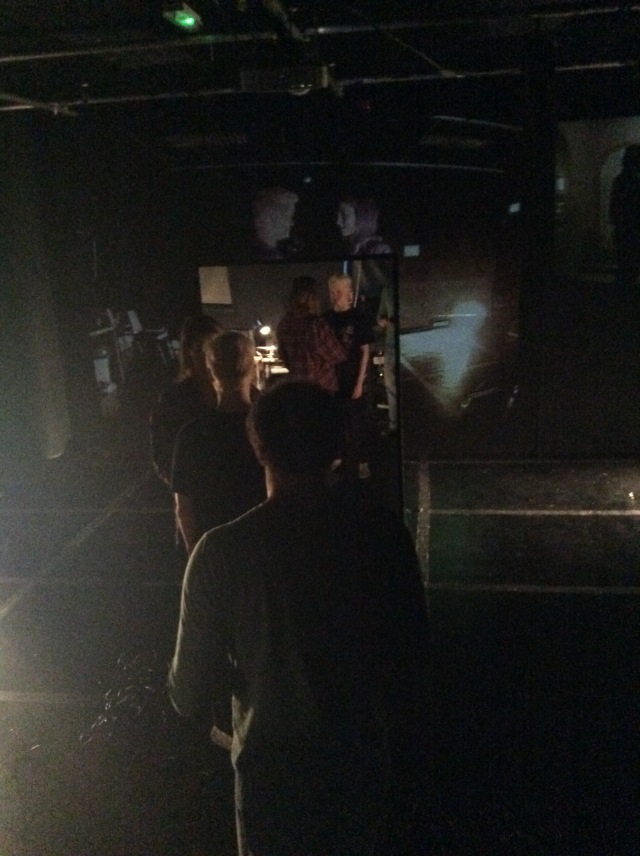
FMP journal 3 – 3/3/2015 – Christopher Jones
I personally want to achieve a performance in which nobody will forget, this would mean everybody will have to put their all into the performance work, which I beleive is a small stepping stone because everybody is already working their hardest. Already this project has given me a major understanding of certain performance work such as working with improvisation and working with script.
My roles on the project vary from scene to scene which I think is good because this means I am able to work with different emotions and to be able to feel different emotions. I personally feel that my work has improved greatly from last year because of the things I am able to accomplish now. I have been given the sound role, I am very happy with this role because I don’t feel like I have worked fully on this aspect. Some of my roles vary from acting to using a camera on others which is extremely difficult and most of us were able to learn this technique at the beginning.
The groups intentions now should be that we all work together and make sure each of our given roles and pulled off adequately, also I think we all need to pay attention to detail in every scene because I feel that we have lost the clarity slightly. I am extremely excited for the upcoming lessons as we have already have 50 minutes worth of a piece within a few weeks so the potential for the next few weeks is huge.
FMP Log- Joshua
Joshua- FMP Log- 24th/25th /27th February 2015
The new scenes that we have started on include Maze 1 and Maze 2 (that feature Wendy and Danny wondering around the maze whilst Jack observes them from the model in the foyer in a clever piece of camera work), ‘Jack Typing’ ( where the breaks in Jack’s mental stability are starting to show, as he starts retaliating towards Wendy), ‘Bathtub’ (where Jack first gains an insight into what really occurs in the hotel and what is expected of him as the caretaker), ‘Toilet‘ (Where Jack learns the truth behind what happened to Delbert Grady) and ‘Breakfast’ (this scene serves as a nice establishment of the background atmosphere at this point).
These scenes were introduced on the Tuesday, with work on these commencing shortly afterwards. First was the division of roles to work on them as the numbers required were not equal to the numbers present.
Maze 1/Maze 2
Actors: Sophia- Wendy, Abby-Danny
Operators: Lief
Camera: Joshua,(Maze 1-2) Stephanie (Maze 1)
Jack Typing
Actors: Joshua- Wendy, Lief- Jack
Operators: Sophia, Chris
Camera: Sean, Abby and Stephanie
Bathtub
Actors: Chris-Jack, Lief- Young Woman, Stephanie- Old Woman, Sean-Danny
Operators: Abby and Sean
Camera: Joshua, Sophia.
Toilet
Actors: Sean- Jack, Abby- Delbert Grady
Operators: Sophia, Chris
Camera: Joshua, Lief
Breakfast
Actors: Sean- Jack, Stephanie- Wendy
Operators: Sophia, Chris
Camera: Joshua, Abby
These scenes are the most recently developed in our work processes and are therefore the main focus of our attention in our lessons. The difficulty that has been with us lately is our attempts to engineer the reverse ‘mirror’ camera shot that comprises ‘Breakfast’ and it’s unique yet frustrating properties. Our efforts to resolve this did produce a solution in the form of a mirror in front of the scene wherein the reflection was filmed, instead of the original.
With this problem resolved, I believe our attentions should now be focused upon the issue of refining the scenes that we have already developed, most notably ‘Baseball Bat’ where the dialogue is decent but the effort expended in the movements is somewhat lacking and ‘Red Rum/Door’ where the actions and camera shots still need to be more precise and timed. The issue with these scenes is that because they are the crux of the film and mainly dynamic scenes, the shots that are needed are by nature, rapid and elusive.
I think the solution to this is a case of familiarity with the film and the finer details within these particular scenes. If a firm grasp of these details was obtained then the pace of the scenes wouldn’t be a problem as we would know enough to proceed at the same speed as the scenes comfortably and without pressure.
Not only will this skill help us within this problem but any others that occur in the course of the developing of the performance.
Abby-Jayne Kemp log
During this unit I want to personally achieve a clear understanding of how working with cameras is different to stage acting and what the different techniques are. I would like to be able to have the skills to work with cameras, for example I would like to be able to successfully work the cameras and be able to operate multiple cameras with lots of different variations. I would also like to improve my live theater skills and be able to successfully tell a story on stage or in front of the camera. One thing I hope to take away from this project is the ability to step in and out of multiple roles like a snap and still be convincing as that character.
My roles withing the project are:
Camera holder: this entails getting the shot 100% perfect while moving around the space and following the actors.
Operator: this entails changing cameras (which will be projected on one screen), adding fades, cross fades and lots of different elements which make the shot projected perfect.
Performer: this entails stepping in and out of character easily but always being convincing as each character you play.
Costume: this entails making sure that all the characters have a key part of costume which identifies them as that character.
The groups intentions are to create a piece of performance which is Breechtian, clarified, live theater and working with cameras. I hope that by pulling together as a group we can replicate the shining to a high standard and be able to prove not only to the viewing public and people who discourage us but to ourselves that we CAN do this and we WILL do this.
LIEF MACIAS- ENTRY 3
From this project I want to gain the ability to become a much stronger actress. This project involves work that I have never had the experience in doing before, especially within performance work. The acting is very strong and precise, recreating a scene as the actors within the film live on set, to be prepared to play the role of many different characters in a short amount of time; this is very difficult as you need to learn to be able to portray the character to their full potential. To not be afraid to perform using different accents, facial expressions that I haven’t attempted before, which are difficult to naturalise them at the time, yet they become more natural the more I rehearse my individual characters and to come in and out of character (becoming a character only when performing in front of the camera shot)
I especially used to feel very uncomfortable acting to an audience- especially when performing as realistic and believable as possible, I tend to find it difficult to forget everyone that is watching me, and I feel very uncomfortable. Yet during the rehearsals of our “Final Major Project” I have found myself becoming much more confident, I find it much easier to act in front of a camera than when performing directly to an audience, which I find to be really interesting, I don’t feel anywhere near as shy, I feel like I can be as loud and dramatic as possible and I won’t feel like I need to suddenly drop out of character and return back to my normal self for comfort, when I was younger I used to constantly dress up and act for the camera with my sisters and play different characters and put shows on, it’s something that feels natural to me. I also find that because we are having to act and be so precise with the physicality’s, facial expressions and actions, that we all have such a high expectations on getting everything perfect that we are all very much supportive of one another, the emotions also feel easier to deliver with the certain actions and facial expressions needed, especially when delivering the certain lines. Also to have the capability to learn a large script as big as we have, and to learn certain sections and scenes by deadlines, and sometimes in ten to fifteen minutes, I hope to expand on this and to be able to learn even larger scripts when needed.
- I want to achieve being able to see camera shots when watching a film or TV show, and being imaginative and creative with what the camera shots produce and capture that scene from different angles, or so the actors can try different variations on their acting. The same scene may be shot three or four or ten different times. To be able to be aware at all times in how many camera people will be needed for each scene, and the easiest most accessible way in achieving them. Leaving with an understanding in how to operate them without any difficulty, and being able to direct whilst multi -tasking and being in the performance myself, rather than standing out and shouting out directions, we have to learn to direct with our own feelings, what feels right to us and performers and what doesn’t. What ways are more effective and how to relate with one another in the space and to the audience in the most suitable way.
- My Roles consist on changing many different characters, with the use of many different emotions, sometimes changing from male to female. This takes dedication to add detail in making this clear to the audience. My role is taking charge of the lighting, therefore making lighting plans for scenes and sets, and taking charge in making sure everything is perfect, whether it being making sure that the lights are safe, they are the right colour and temperature, in the right places and are put away with care.
- I feel like the past couple of weeks, the group and I have really managed to work hard together, we have produced a really strong bond with one another, an understanding in how each of us work, and this is something really important especially when having to do everything that involves relying on everyone, and doing everything together the work is intense and we are having to be patient especially when working with the cameras, and taking time to learn and work on the individual shots and then placing them together. The groups intentions and aim is to get every word within the script right, to keep to our deadlines and work hard in learning every scene given, and to keep it up throughout in order to concentrate on the physical work, where we need to be energetic and enthusiastic about it, in order to leave feeling accomplished and feel the bond that we have created throughout the rehearsals within the performance and the work that we are producing, whether it is emotionally when performing to a camera, or the person behind it or to our partner or group we are working with.
Log entry 3 – Sophia
I want to achieve a greater understanding of creating performance work at such a high and detailed level and also I think this will really improve my problem solving skills. I think this performance is really challenging for us as performers and we have to overcome many obstacles to get what we want, this really helps us work as a group to overcome any problems we may face in the process. So far this process has really made me think in a much higher detail than I have done before. I think that the directors project really helped me develop these skills and now I want to develop them further. Especially if I want to go into that route next year in university.
I am the set designer so I am the main person in charge of how the space will be organised and what it will look like. I will work mostly with the model that we are making for the Emily Davies studio to try out different variations of how the set will be designed with scale models of the props so I can move them around. I have watched the film again so I can make notes on what we will need in terms of the set. I have already got a fairly strong idea of how it will look so I am enjoying this role. I am also assistant lighting manager with Lief. This involves working out what lighting we will need and making sure all of the lighting gets set up and is all working how we want it to be. I also have a role of a performer, so I need to learn all of my lines and choreography to the best standard I can for the performance and problem solve any issues we need to overcome. I am also a camera operator and a technical operator which involves me operating the camera to get certain shots and switching between three different cameras in order to create the scene we are working on.
I think our groups intentions should be to work together as a strong team to create a memorable performance. We all want to leave college with good marks so we all should try our hardest to make that happen. I also think that this is our last major project we will work on together so we should enjoy the process as much as we can and have fun with it.
Stephanie Pearson Journal Entry 3
Journal Entry 3
At the end of this project personally I would like to be able to achieve a sense of accomplishments in being able to complete and participate in such a complicated, layered and detailed performance. I would also like to be able to improve my analytical skills in being able to analyse how certain camera shots, or certain actions or prop designs mean symbolically or why the directors used them in the original filming of ‘The Shining’. During this project I also want to be able to develop my directing skills in being able to see how each of the three different cameras should be positioned to get the same camera shots as in the original. I would also develop these directing skills by being able to direct other members in my class to what position they need to be in for the different scenes so that the camera shots are as identical as we can get them to the original.
Within this project I have the technical role of stage manager which means I have to make sure I take all the notes on the technical and set design of the performance, and also have to make sure everyone else is doing ok in their jobs and discuss ideas with them. As part of the project everyone including myself has the roles of being directors in how the cameras should be positioned, and also how the other members of our group will be performing the actors in these scenes. I also have the job in certain scenes in ether being an actor, camera operator and the technical operator which involves me being able to switch from these three different jobs, which is the demonstration of Brechtian technique.
I think the groups intentions on this project should be that everyone should concentrate in the development of the performance, and should work together efficiently to be able to communicate ideas and experiment with these ideas. I also think that everyone should be able to concentrate on the work and learn their lines and doo the best they can do during rehearsals and attend each of our FMP lessons as it causes complications when people are absent.
‘Post’ dramatic Theatre 2

LIEF MACIAS- ENTRY TWO
What have we done so far?
At the beginning of the rehearsal, we went to see the location where we will be performing our Final Major Project. This was really helpful in seeing how we as performers can work within the space, and how the space could look visually, where our audience will be seated or stood, how much of a space we have for our physical work compared to the rehearsal space we are using within college. Therefore it was really exciting as this gave instant ideas as to how our performance space will look.
We had new ideas such as having a long operating desk the length of the performance space, where the operators will be sat with each of the equipment needed such as laptops, lighting, sound and other things such as our scripts and props to be laid. This was great because it made the operators more visual and involved, by having them centre of the stage and in front of us; this made sense as to having the idea of “Control” and the recreation of making “The Shining”, with the white dance floor in the middle of the space in front of a massive projector where our film will be playing live.
We also managed to decide on how many performances we were able to do and how many would be appropriate, as the location is able to seat 60 or more people, which is a lot more than we would be able to have within college, therefore we decided on doing three to four performances, as it would be filled and therefore we wouldn’t need to perform to many times.
Through recapping over each of the scenes made, we were able to move on to the next three new scenes, where we also had to come up with new gestures of each individual scene, playing them together, in order to create a physical piece with the use of “fast and slow”, “Big and small”, “Repetitive” and “Percentages”. This was a lot easier this time as we had done it once before, therefore we knew what was expected from us and we were much faster in creating our movements. I felt like the music was also really helpful to work along-side to, as it set a certain atmosphere and mood. It made me feel an urge to move and work, the music also surprised many of us as it seemed to work really well with certain movements within the group work. Therefore we considered in using it within the actual performance. This really helped with the concentration as if it is quiet, I tend to become more aware of my surroundings and who is around and watching me, I prefer to be able to be in “the mode”, rather than any distractions.
It was lovely to see what each of us had produced and to share it with one another, as we aren’t able to speak I find it is amazing to see how much work we can produce in such a short amount of time, some beautiful movements with the contrast of harsh or disturbing.
We began working on the “Naked woman” scene, where we were thinking of repeating the scene three times, having Stephanie, Abby and I be the three women with our partners. This scene was really fun to do as it was very different to any of the other scenes, it has a slight comedy element to it as the woman isn’t meant to be there, it is all in “Jacks” imagination, as she’s a very beautiful woman who then turns old and wrinkly. This made us work well with our partners as it meant working close with one another, which I think some people found uncomfortable in either pretending to kiss one another or actually having to.
What needs to be done next? Next rehearsal, where everyone will hopefully be taking part, as we have struggled slightly in not being able to recap over every scene, or every scene to its full potential, therefore we really need to go over every scene with everyone, performing as well as possible, also making sure we are sure as to our individual movements and movements when filming or operating. We need to keep adding layers as we really made a start of adding layers to the performance in making it detailed and in depth, and began putting all the pieces together, It would be really great if we sat down for a few minutes before each rehearsal to talk about any ideas we have towards the performance, as we could perhaps incorporate it during or as the rehearsals go on.
Christopher Jones – FMP journal 2 12/2/14
What have we done so far?
At the moment we have 7 scenes in total in which we have run through completely and tried to clarify as much as possible. We have added many more layers to each scene including physical movements related to the three scenes the operators also had to think of movements and gestures etc. to include while changing the cameras which I found difficult. To make our camera work easier we have put up a small screen in which the film is on to help us improve with our quality and clarity. The eighth scene has been started which is the bath scene were three of the groups woman represent the woman in the film itself but this has not been completed yet. In the bar scene we have added the song which is playing in the background in which we have to sing and learn the song word for word, i found this fairly easy. We visited the space in the university so that we could have more of a clear understanding on what we were working with, also pictures were taken so we could work with our space in the performance space as we are beginning to work on were everything is going to be spaced. We all then discussed on how the lighting and sound is going to be operated etc.
What have we discovered?
Similar to last week not all of the work has been easy such as adding movements while operating has been extremely difficult as I found that having to worry about the clarity of the movement and the timing of the scene change was difficult. Clarity in camera work is beginning to take shape but there is a major problem with comparing the film and the actual camera. To fix this problem we must be very careful with moving while having the camera in our hands. I feel that the performance is beginning to take shape. We have also discovered that our working space is much larger than originally thought which i believe will make our performance better if we adjust to the space.
What needs to be done next?
We will need to create more scenes in order for our performance to work and along with these scenes we will need to add more layers such a physical movements or text. The space also needs to start taking shape. The group need to start having more clarity in the camera work and physical because without this i do not believe it will be as strong.
Joshua- FMP Log- 10/02/2015/ 11/02/15
Joshua- FMP Log – 10/02/2015 – 11/02/15
What have we done?
The practice of adding our existing movements to the work that we do in the scenes so far extend to the ‘Your Money Is No Good Here’, Baseball Bat and the ‘You Did This To Him’.
- ‘Your Money Is No Good Here’- Camera Operators: Stephanie and Joshua. Actors: Lief and Abby. Camera Holders: Sophia and Chris. Movements: On Steph’s part, simple hand gestures that can be performed at the desk are the majority for this scene but towards the end of it, Joshua gets up, moves away from the desk and into the performance space where the movements include repetition of floor movements before moving back to the desk. Another addition to this scene is live singing with the song being ‘Midnight, Stars and You’. The use of this is to be in the background of this scene as it is in the film with another use scheduled towards the end of the film but as we have not reached that part yet, it does not bear that much concern.
- Baseball Bat- Camera Operators: Sophia and Chris. Camera Holders: Lief and Abby. Actors: Stephanie and Joshua. Movements: These were to last throughout the entirety of the scene with Lief utilising the arm that was holding the camera to ‘walk’ her hand along in an movement that lasted the entirety of that scene.
- ‘You Did This To Him’- Camera Operators: Lief and Abby. Camera Holders: Stephanie and Joshua. Actors: Sean, Sophia and Chris. Movements: These are few and far between in this scene. The only ones that are evident are Joshua’s Solo 1 hand movements in the first scene (towards Sean/Jack) and the second set of hand movements during Chris’s scene.Thursday saw us visiting our future performance space in the Arts Centre which roughly was 30ft in height and 17ft in width, double the size of the space we are normally accustomed to working in. Far from being a hindrance, there are still some changes to consider when working with a space this size:
- Benefits
- Space enough to show all that we need
- The room itself is easily equipable for our needs
Disadvantages
- The performance space itself won’t be that large
- Have to decide what will be in there What have we discovered? What do we have to do next?
- Our future objectives include allotting of roles for the performance itself which will include:
- That so far, if all the scenes that have been worked through are added up in terms of duration, that we are presently 1/3 through the film so far with 30 minutes of scene work under our belts, with another 60 minutes worth still left to go.
- LX (Lighting Director)
- SFX ( Sound Director)
- Costumes
- Props
- Video
- Stage Manager (overall matters)
- Stage Director (everyday matters)
These roles will have to be decided as our expertise upon each of these pioneers becomes more apparent. However, owing to the model of the Overlook Hotel that Joshua constructed for scale purposes, the understanding seems to be him for the role of Props Manager.
Stephanie Pearson Journal Entry 2
Journal Entry 2
So far in the rehearsals we have managed to find eight different scenes from The Shining, and have managed to successfully manage to recreate the camera shots for each of these scenes to the best quality that we can. We have also managed to achieve creating two different sets of solos for everyone and also two different sets of duos for everyone so far based on gestural movements from three more different scenes. These solo movements will then be devolved into creating gestures for when members of the group are the camera people or the technical operators. For the duos so far we have no initial idea of how we can incorporate them into the space at the moment, as we need everyone to either be a performer, operator or camera person. In the rehearsals were able to implement the solo choreography into six out of the eight scenes by thinking that less is more in terms of using big bold movements, but by using small gestural movements, we were then able to get detailed precision of when these moves will be done in relationship to the gestures done by the performers, and also the relationship with the audience. Also in rehearsals we have experimented with the white dance floor to see how it could affect the lighting quality if we had floor lighting. We thought the white dance floor will give a better effect as it will help with the camera video quality by bouncing light back up onto the performers and will also help in making us performers and camera video quality better. We then experimented with floor lighting to see how it would affect the quality of the video which will be projected on the back wall of the space. As we did this we found out that floor lights aren’t as good as the lighting on top on the grid as it gives too much light bouncing back up from the white dance floor.
So far during the process I find that I am getting a better understanding of how the space will look like after going to the Emily Davies Studio which we will be performing in, and I also find I am improving on my directing skills by being able to see the difference in camera angles between our version of the scenes and the original version. Also I find that I am increasing my confidence in working with the different technical operation desks needed to work the cameras and projectors. During the process as a group I have noticed that everyone is being more analytical when it comes to picking out detail when recreating the camera shots based on the camera shots in the original version of The Shining.
The next steps we need to do in our rehearsal is to make sure every member of the group is present so we know each detail of where all the cameras will be and, to get the operations for the scenes we already have, to be functioning fully. We will also have to starts putting out the dance floor and seeing what props we need so we can start using them correctly and get the detail of how these props are being used so we get clarity in the movements, to be as close as possible to how it’s being done in The Shining.
Sophia Brydie – Log entry 1 – 09/02/15
So far we have worked on seven different scenes from The Shining. We have all been put as different characters in each scene and spent our time working on them in as much detail as we can so we can get it exact to the original scene. We have also created physical solos and duets by picking out simple gestures from three of the scenes and playing about with them, for example, using different speeds, using our body as a stage and travelling with the movement. I find this a really interesting way of creating work because there’s not really a limit to what you can do as long as it relates back to the original movement. And finally we have worked with the cameras and the shots from the film to get it right. I am finding this process really enjoyable so far, I think it will become more complicated when we work on every scene without any prompts and just with the backing music instead of cueing from the original scene. I reckon I will really struggle with timings because I always seem to rush what I am doing.
Throughout this we have discovered how to set up the cameras, tellies and the projectors properly so we can work with them efficiently. Also I think we have discovered that getting the camera shots exact is actually really difficult, because the cameras are round it is really difficult to get them straight so we really have to concentrate on the angle. We are also doing a lot of problem solving so far, mostly to do with the camera work, for example we have to do a lot of jumping in and out of shots but in time for the change so the camera people aren’t in shot for the scene.
Our next steps are to continue learning our scenes paying attention to detail and know them completely so we don’t have to be prompted. We also need to go over them all in order with just the backing music so we can get the gist of the exact timings, and also to get the transitions between the scenes smooth and efficient. I think we also need to work on clarifying the camera work so it runs smoothly.
LIEF MACIAS- FMP JOURNAL 9/02/2015 (
| What was achieved in rehearsal?
1.Learning individual scenes 2.working on actions and movements 3.Working with Cameras 4) Creating physical movements |
9/2/15
What have we done so far?
- Within our rehearsal we worked on various scenes, the scene learning involved partner or group work, learning the lines and every action with detail, every facial expression and gesture. Through the use of headphones, this was something that involved a lot of concentration, as we had to make sure we were in time with the video or mp3 track that was being played in our ears. Especially as we rely on our partners as much as ourselves to deliver the lines and to deliver them in time.
- We performed each scene firstly with the vocals only in order to get the feel of the scene, and the atmosphere with the background music playing out loud, this helped to get used to delivering the lines. And we then did the scenes through delivering the lines vocally and physically. This really helped with adding an emotion, as it came more naturally in the way we projected our speech and the speech came more naturally in using facial expressions.
- Looking at each camera shot within the scenes, in order to know which cameras to use (Camera 1, 2 and 3) making it easier for the operators to know when to cut from each shot. I found the operating a lot easier than I thought it was going to be, especially when marking each of the buttons as to which camera is operated by them. To save any complications or forgetting half way through a scene, as when this happens you are able to see the cameras changing between one another when looking for the right camera that is needed on the operator.
4)Working with the physical- we chose gestures from scenes that we could remember and perform in detail, we extended and explored with our gestures with differernt timings (slow motion, fast,) , repeating the gestures more than once, we even explored by placing and performing the gestures on our bodies, this was something that visually looked really interesting, and was interesting to think using different and new ideas that we may not have thought about before. Through placing a gesture on the body this added more of a story to the action, rather than performing them all the same, we added a mixture and placed everything together in an order that best suited us individually.
What needs to be done next?
- Go over each of the seven scenes that we have learnt and the physical language and movements that are involved. In order to refresh our minds and memorys, also making sure everything is perfect and trying to extend every run through in order to make the scene more intense and meaningful- to add an imagination and emotion.
- To work with the cameras- having run throughs in order to see how far we get during a run through in order to make it fluid. We discovered that it is much easier to stop after each shot in order to make sure that each scene is exactly the same as in the film, or to see ways of getting around and solving any problems that we discover.
- To add physical movements within the camera work, to become choreography within the scene instead of just simply walking, this makes it a lot more visual, and adds a connection with the actors within the scene, as our gestures and movements relate to certain elements within each of the shots. .
- Create a ground plan in order to start visualising the space and set that we have in order to make transitions easier, and to make it easier in developing new ideas in choreography or imagery.
The electric typwriter I have which works.
FMP Journal 1 4/2/15 – Christoper Jones
What have we done so far?
We began by having three scenes from the movie and we tried to recreate it with every facial expression and gesture etc once this was accomplished we began thinking of camera angles and where they were spaced out, I made a quick diagram showing exactly were each camera was layered out which helped me with actually doing it. After having a good few run-throughs we were asked to add 5 movements out of the three scenes using different techniques such as repetition, fragmentation etc after 30 minutes or so we then performed them in front of the group in which after we had been given feedback. Partners were picked for us to teach each other our solos in complete silence which i found extremely difficult, we weren’t sure however were to add this into our scenes.
What have we discovered?
I found it very difficult to almost copy my character which was Danny as he had very small movements as he was a child, also the cameras was a huge learning curve for me as i felt that i had to completely perfect the camera which was difficult as they were so sensitive to any kind of movement but luckily i have found a way to do it. Surprisingly I found that operating was the easiest for me as I felt I was in a much more relaxed and controlled environment and that i was able to look at the original scenes to make sure i had clarity in my scene changes. We have learnt that the space that we will be working with is much larger which I personally think will be easier for us. I felt like the duets went very well, as I had thought before doing the exercise it was going to be difficult but because we weren’t speaking there were no distractions to us working.
What needs to be done next?
I feel that we need to clarify our movements as a group in order for us to be able to connect to it more I also think this relates to the camera work because without clarity i do not think we will be able to pull it off as good as we can. We need to add more scenes to our performance in order to carry on also adding movements to them then clarify.
viewing the Emily Davies studio 11th feb
Tech experimentation 12th feb
today’s tech lesson – white floor
‘Post’ dramatic theatre
First visit to Emily Davies studio
Joshua-FMP Log
Joshua Tofani-Smith- FMP- 4/2/2015
What have we done?
Progress with the Scenes
- Toilet – The movements for this scene have been worked through although not with the camera as on the day in question, there was an issue with numbers in attendance. Otherwise though, looking good for next Wednesday.
- Door- The main issue with this scene apart from the overwhelming number of camera switches (30+) is the positioning with regards to the angles that the camera must be in order to accurately capture the equivalent moment from the film. We had difficulty running this process smoothly, owing to the aforementioned problem. One solution we found was to use a second projector to run the film alongside the real-time camera footage in order to ensure a greater degree of accuracy in the re-enactment. This had a noticeable effect on performance and as a result the first complete run-through of this scene was achieved.
- Twins- The production of this scene was relatively straight forward except for one minor snag. The section that had the twins alternate between alive and creepy to dead, bloody and slaughtered, often in the space of a single camera switch, proved difficult to replicate until we found a solution by having Stephanie and Abby as the ‘alive and creepy’ twins and Lief and Sophia as the ‘dead, bloody and slaughtered’ twins and merely alternating the view over Chris’s shoulder.
- Typewriter- This scene was another that was only completed today, having been thrown together by the use of a spare typewriter and a table. No major problems with this scene apart from the inconvenience of having me in view in the shot when I do not appear until the end of the scene. Alternate solutions that have been tried such disguising myself with a blackout curtain until it is my time do not work as the cameras, when in dark conditions, seem to pick out dark objects in an exceptional shade of purple, rendering my strategy useless . Further experimentation will be necessary for this problem.
- What have we discovered?
- That some scenes are more difficult to film than others, specifically the elevator doors opening to reveal a flood of blood pouring out and the opening scenes of the Overlook Hotel from the air. Another problem is about finding the correct props so that certain scenes will be possible to achieve, such as the ‘Twins’ scene where a red tricycle is necessary in order to fulfil that scene and the ‘Door’ scene where an (blunt) axe is used to break through a (paper/cardboard/plywood) door, both of which will be difficult to source and transport, which is why the development of a props list would enable us to keep track of what we have at the moment and what is ongoing.
- What is to be done next?
- In response to the ‘impractical’ scenes that need to be developed, such as the elevator full of blood and the aerial shots of the Overlook Hotel, I have put forward the case that the most successful method to do this would be to use scaled down models of these locations in order to film them more easily. As of this writing, the elevator model has already been produced but not tested and the front view of the hotel is under development.
Stephanie Pearson Journal Entry 1
Journal Entry 1
So far in our rehearsals we have managed to pick out seven different scenes from The Shining which we will be recreating using three portable cameras. We have then managed to cast who is going to be playing the characters in these different scenes. After doing this we then went into our small groups for our scenes and went over them vocally by listening to how the original casts say and how they speak. We then carried on with our scenes by physicalizing them in the space getting the feeling of how they moved around and how it could make filming these scenes live more accessible within the amount of time we have to get these scenes, and more which we will be using. After getting the physicality of our scenes so far we have spent time in detail going over how the camera angles work and recreating them, and also recreating the facial expressions and physical actions of the characters we will be portraying. While I was away the rest of the group managed to create several solo and duet physical pieces based on gestures based on The Shining.
During the process so far we have discovered how to set up three cameras to two mixer desks, setting up a projector so we can see the camera shots and also learning how to switch between the three cameras so we can achieve the quick snappy camera shot changes within The Shining recreation. Through recreating the different camera shots we have found out that it is difficult at some points to figure out which camera should be used for the different types of camera shots, and that switching between the different camera shots can be confusing and hard to do when you need to switch between the three cameras quickly. As a group we have also found out that picking up the detail on the physicality detail on the original cast is tricky as it’s hard to concentrate on doing these detailed acting while also having to be careful on the camera shots, as it’s different from performing live without having to think about the way you are positioned in a camera shot, which should be as similar to the original as possible.
The next steps for our rehearsals would be for everyone to learn all of their lines for all of their scenes so far so that we can start listening to the audio tracks without voices quicker so we get to know our line queues based on the sounds alone. Also we will need to run through all of the scenes so far in order of the film so we can work on transitions between each scene, so that they are smooth and are quick so that we don’t waste time. We will also be trying to recreating some camera shots by using mannequins and props to show Brechtian quality and to make some camera shots easier to do. We will also have to figure out how we can multilayer the performance by using the solo and duets the rest of the group as created while I was away.
